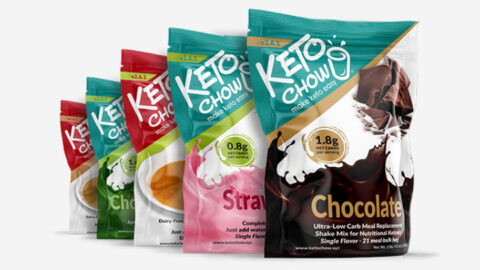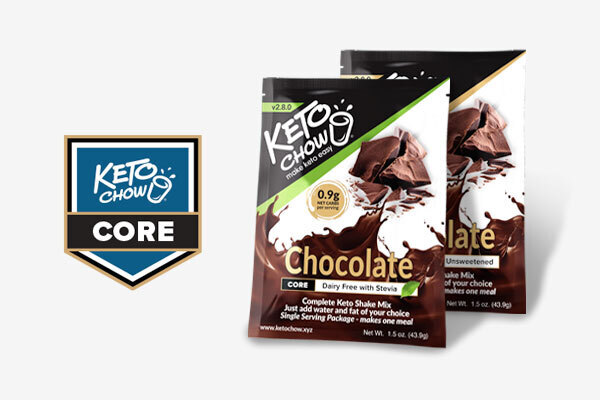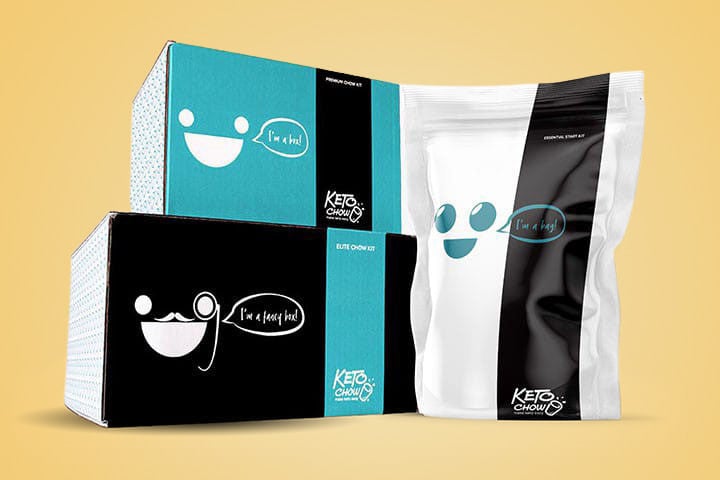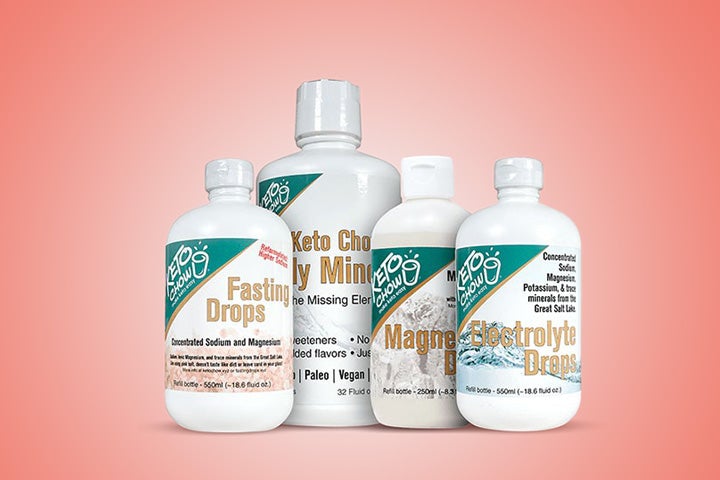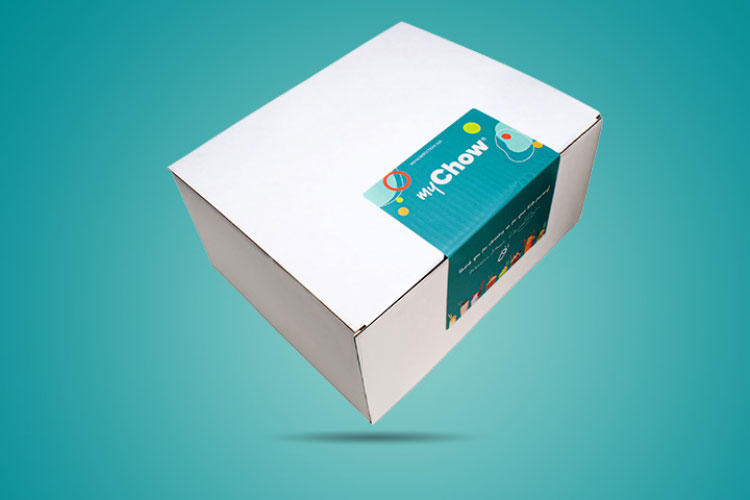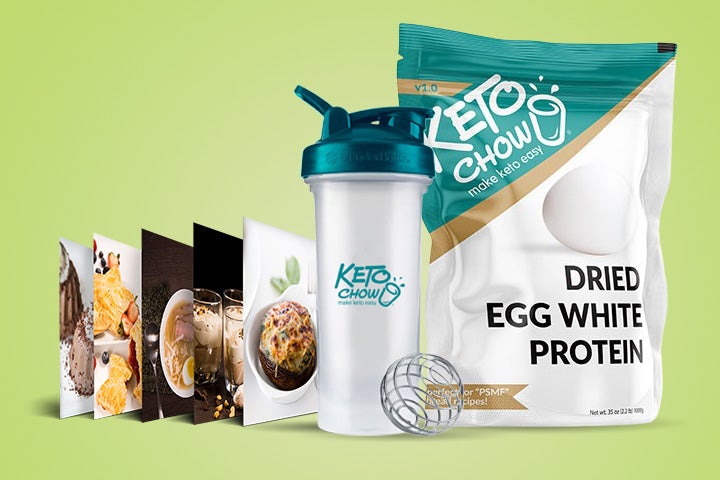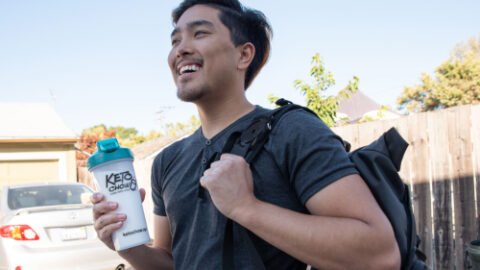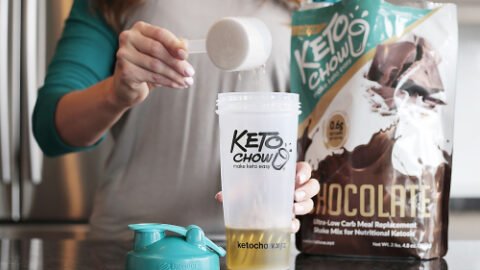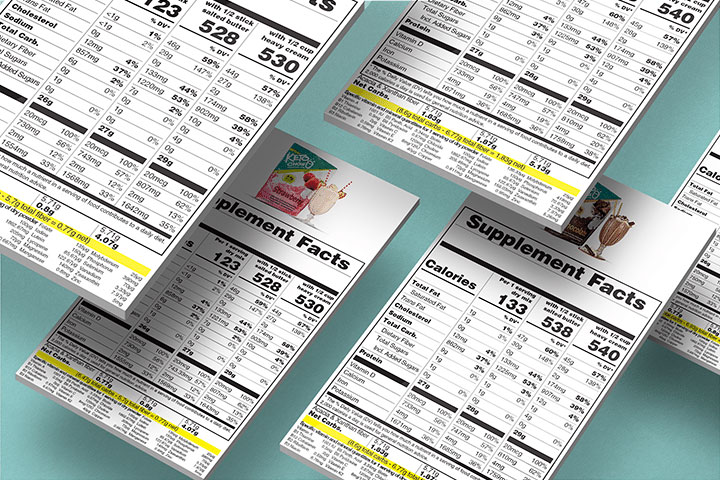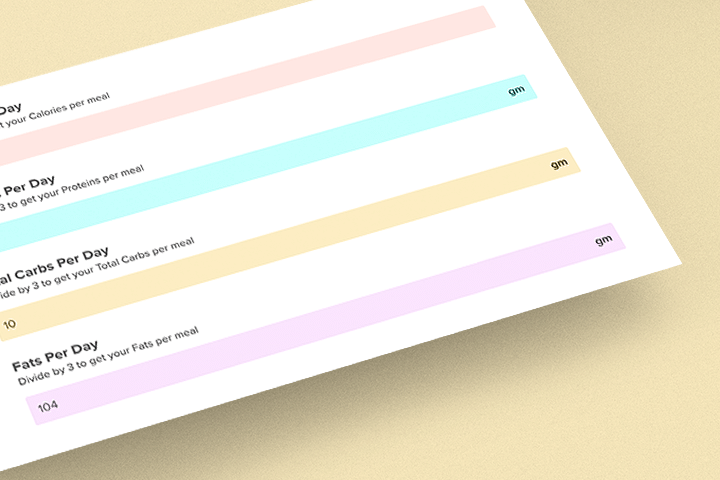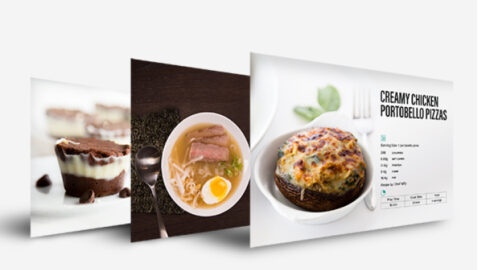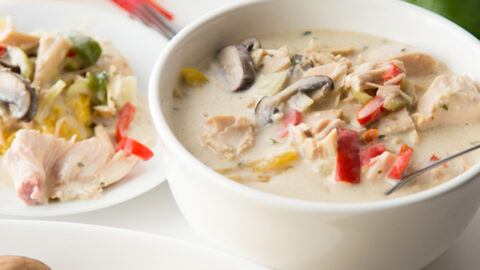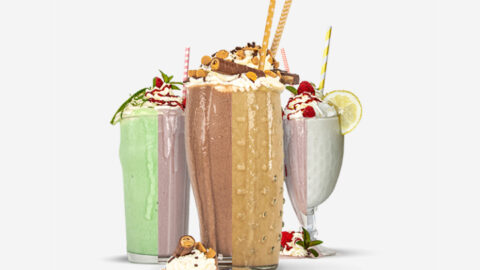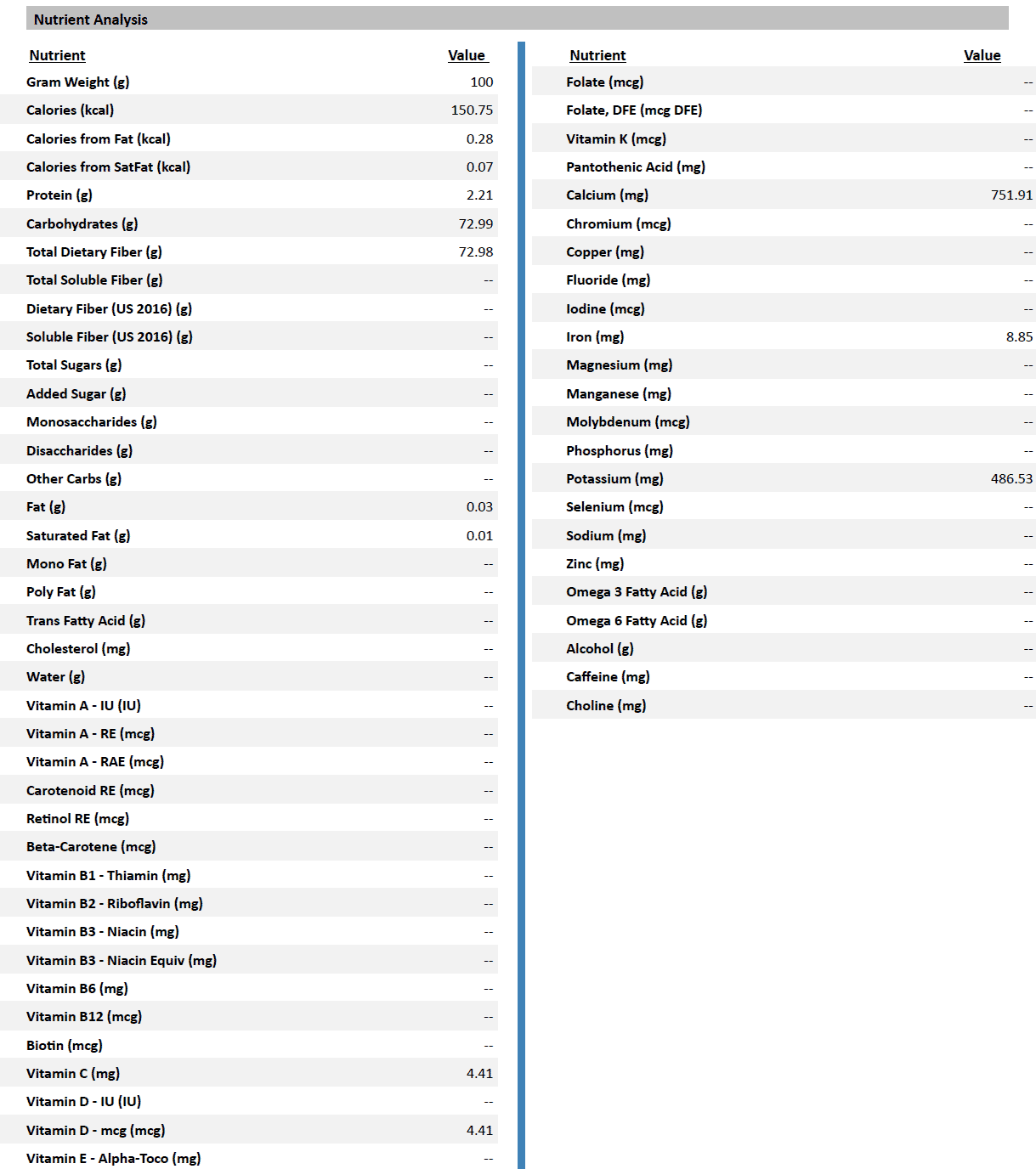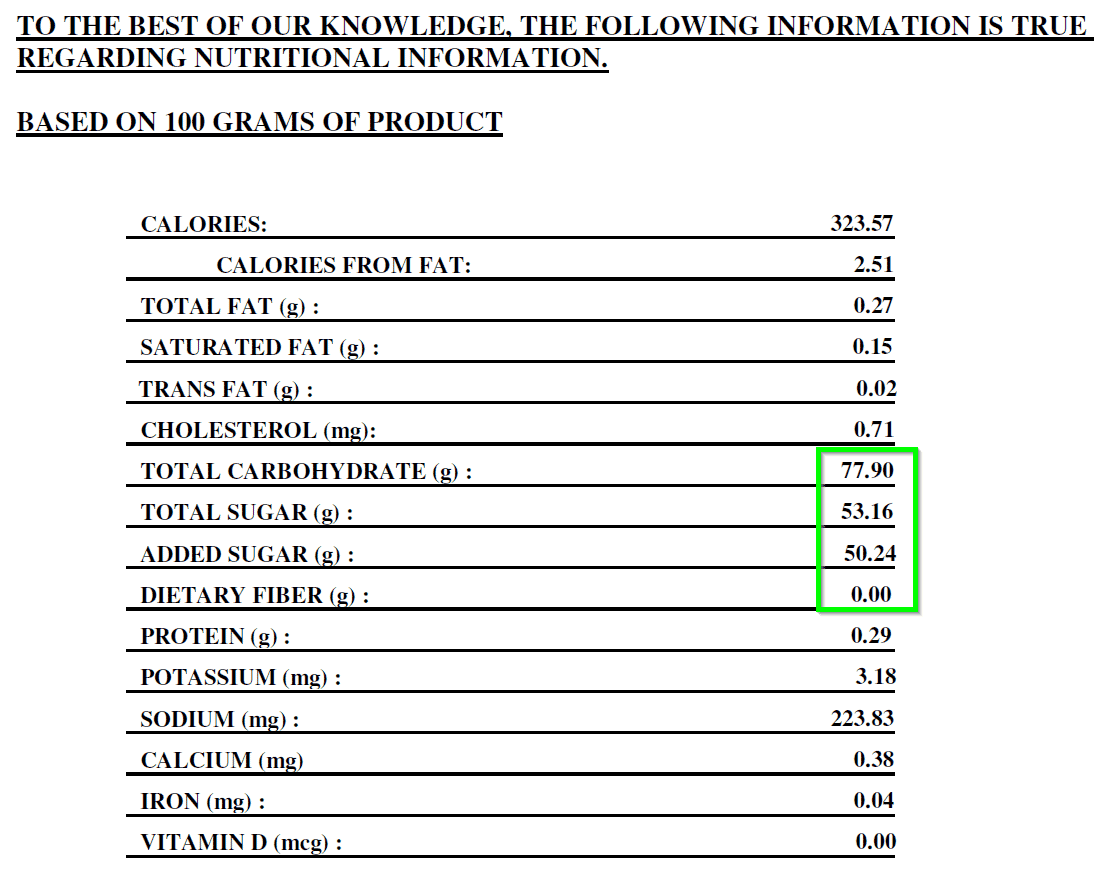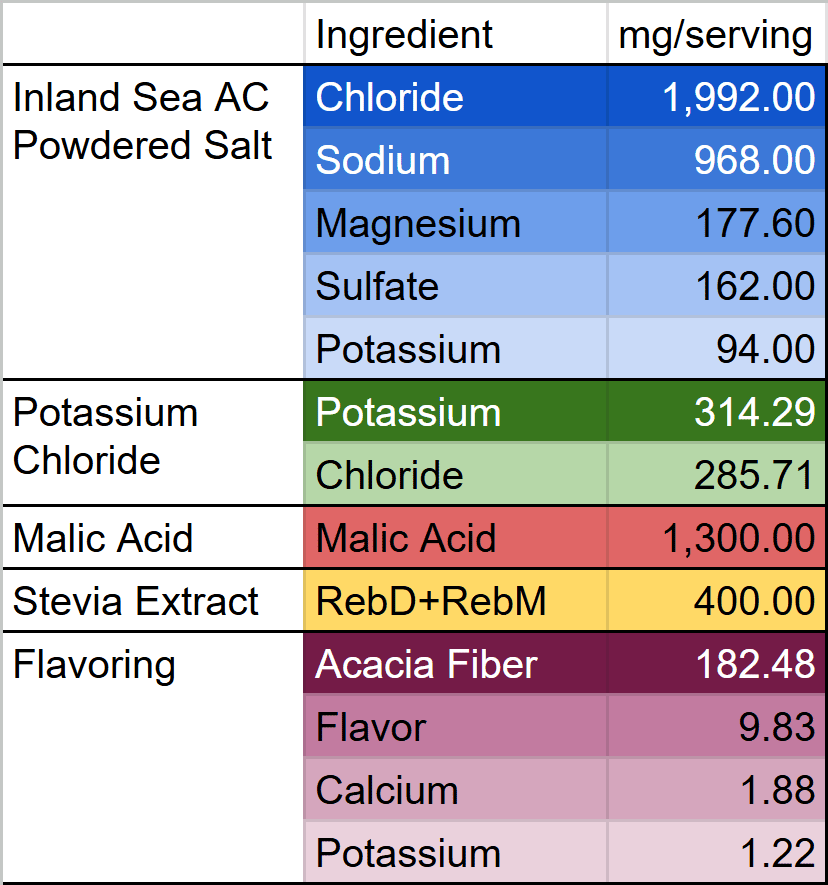Frequently Asked Questions.
What type of question do you have today?
Ordering & Shipping
General Product Info
Nutrition & Dietary
Keto Chow Preparation
Electrolytes
Ordering & Shipping:
How does the increasing discount on the “build-your-bundle” work?
Short version:
The build-your-bundle myChow Kit starts at a 15% discount. Each time the subscription renews, an additional discount is added and eventually it adds to roughly 20% off the original price of the bundle. So long as the bundle subscription is not canceled, it will remain at the roughly 20% discount. I would recommend you stop reading there =)
OK, now for the long version, you have been warned:
When the bundle is created, a 15% discount is applied to the original amount. OK, that’s easy.
The first renewal, a 2% discount is added, but that discount amount is applied to the NEW subtotal, not the original amount. So it’s 15% off the original and 2% off the new subtotal. That makes 16.7% off the original amount. Because MATH.
The same 2% is added 2 more times but the new subtotal is smaller so the 2% represents a smaller discount (on the original amount). It’s still 2% off each time but compounding discounts are as fun as compounding interest, it adds up in weird ways.
So the discount goes from 15% > 16.7% > 18.366% > 19.9987% which is not exactly 20% off, but it’s the closest we can get. It should only be off by +/- $0.01. To make the math below easier to follow, I’ve started with a $100 bundle, be aware that the minimum for the bundle is actually $110
| Sequence | Total Orders | Discount Added | Cumulative discounts | Subtotal | New Discount | New subtotal | Discount off Original |
|---|---|---|---|---|---|---|---|
| Original Order | 1 | 15% | 15 | $100.00 | $15.00 | $85.00 | 15.00% |
| Renewal 1 | 2 | 2% | 15 + 2 | $85.00 | $1.70 | $83.30 | 16.70% |
| Renewal 2 | 3 | 2% | 15 + 2 + 2 | $83.30 | $1.666 | $81.634 | 18.366% |
| Renewal 3 | 4 | 2% | 15 + 2 + 2 + 2 | $81.634 | $1.6327 | $80.0013 | 19.9987% |
| Renewal 4 | 5 | 0% | 15 + 2 + 2 + 2 | $80.0013 | $0.00 | $80.0013 | 19.9987% |
| Renewal 5 | 6 | 0% | 15 + 2 + 2 + 2 | $80.0013 | $0.00 | $80.0013 | 19.9987% |
| Renewal 6 | 7 | 0% | 15 + 2 + 2 + 2 | $80.0013 | $0.00 | $80.0013 | 19.9987% |
| etc… | 8, 9, 10, etc… | 0% | 15 + 2 + 2 + 2 | $80.0013 | $0.00 | $80.0013 | 19.9987% |
So why have this weird discount on discount on discount? it’s a limitation of the subscription engine and how it applies discounts. Ideally Discount A would be replaced by Discount B would be replaced by Discount C, etc… but the software does not allow that, it only allows stacking one on top of the other. Yes, it is confusing, but we warned you it would be =)
What notifications are sent for upcoming and processed subscriptions?
- When you create a subscription, you will receive an email with subscription details, including a link to manage your subscription. This is also available in your customer account page.
- Emails are sent if a subscription is paused, resumed, canceled, or skipped.
- 3 days before an upcoming subscription order, you will receive an email reminder that the subscription is coming, along with a link to manage the subscription. We HIGHLY recommend that you take a few minutes to review your subscription when you get this email – you may find that some products have gone out of stock and are not currently available, and you may even find NEW products that you may want to add as part of your subscription.
- Emails are sent if there are any problems with the subscription renewal order:
- If any products are out of stock and your subscription is “partially billed” – you will be notified which items were skipped and which items were processed.
- If payment fails, you will be notified and we will retry the payment again the next day, for 5 days.
- If your payment is close to expiring, emails will be sent out at 30, 15 and 3 days before card expiry date.
Do you charge sales tax? How is sales tax calculated?
We charge sales tax in the areas that require us to collect sales tax, the amount they tell us to collect, on the goods they tell us we must collect sales tax for. Some items will be taxable at different rates than others and in different locales.
We use Avalara, which hooks directly into our shopping cart system. It looks at a few factors to determine what (if any) sales tax needs to be collected for a specific item or items in an order:
- The address of the person we will be shipping to so that the tax jurisdiction can be determined. Some states have 1 unified tax rate, others have different rates for different house numbers on the same street.
- Some customers have provided us with tax-exempt information – Permanently disabled veterans in Oklahoma, for example, come up fairly often. It looks to see if they are exempt
- Finally, the tax classification of each item in the order is individually analyzed to determine the tax rate. Some tax jurisdictions tax things like a plastic blender bottle at 7.65% while an unprepared food like a meal shake is 3%. The final tax amount is determined and shown to the customer at check out.
- On the back end of the tax service, it keeps track of the amount of tax collected for each tax jurisdiction and provides a report for filing monthly sales taxes in each one – that’s our job.
Each item on our site is classified with an Avalara Tax ID. Many are very specific and easy to decide “yep, that’s the one we should use” but others are harder to determine and we’ve even had instances where a tax authority came back and told us that they had decided our classification was incorrect and we needed to change it and pay back tax (that was never collected) plus fines. “Thank you sir, may I have another!” is the only allowed response. If you have been purchasing products from us for some time and we did not collect sales tax in the past, but you are seeing sales tax collected now, it is typically either:
- We passed the threshold of total orders or dollar amount of sales to a state and must now collect tax (see below)
- The item you are purchasing had a change to its tax classification usually as a result of an audit by a tax authority
A few years ago there was a Supreme Court decision (South Dakota vs. Wayfair) that allowed U.S. States to force retailers to collect sales tax, even if the retailer was outside their tax jurisdiction and did not have an actual presence (called a “nexus”). Most states have a specific number of orders per year or a dollar amount of orders that are sold to customers within their jurisdiction that must be reached before a retailer has to start collecting tax. In many states, if you buy something online and you aren’t charged sales tax, you are legally obligated to track that amount and pay sales tax along with your state tax return – many ignore this until their state tax commission audits their expenses and fines them, ask how we know =) A bunch of states joined the Streamlined Sales Tax group (SST) making it extremely easy for retailers to sign up and manage sales tax to those states, and We think this was a great move, the other states are sometimes easy to set up and others are exceptionally difficult with insane regulatory hoops – it’s like they don’t want money.
Can I still get free shipping on my subscription, even though it’s less than $100?
All myChow subscriptions will receive free shipping, but other subscriptions will still need to be over $100 in order to qualify for free shipping. You can log in to visit your account and edit the contents or combine subscriptions in your account so that it does qualify.
Can I still get free shipping if I use reward points or a gift card?
Absolutely! Just remember that the subtotal needs to be $100 or more before tax and after any discounts.
My order was $100 or more. Why didn’t I get free shipping?
Please note that in order to receive free shipping, your order subtotal must be $100 or more—before tax and after any discounts/special offers. If your order met this minimum but you did not receive free shipping, please feel free to reach out to our customer service team for assistance.
Can I pay with PayPal or Amazon Pay?
In November 2022, after a particularly worrisome run of quite severe problems with PayPal, we decided to remove PayPal as one of our default payment methods. Transactions that are processed through PayPal also cost us roughly twice as much as payments made via credit card. We do have the ability to enable PayPal as a payment option on specific accounts – you just need to contact Keto Chow customer service and they can get you set up.
Amazon Pay was removed as a payment method in May 2020 and will not be coming back, ever. It’s a long story but the important part is that Amazon’s policies don’t work for us.
We do accept Credit card payments which also includes ApplePay and GooglePay, as well as a multitude of Cryptocurrency payment methods (which get used like once a year to be honest).
Can I use “expired” Keto Chow?
The date on each Keto Chow package isn’t an “expiration” date, it’s a “best by” date.
Keto Chow contains various vitamins that are affected by time and oxygen (among other things, but those are the main detrimental factors), along with flavors and protein. The vitamins, in particular, start to lose their potency over time, and eventually, they end up being below the levels shown on the nutrition panel for Keto Chow. So nutrient “X” may be at, say, 130% level on the day it’s packaged, 100% level at 2 years, and 75% level at 4 years (again this is an example to illustrate). It’s not a linear progression and various nutrients have different degradation curves. If you want to ensure that you are getting the exact vitamin levels shown on the Keto Chow packaging, please consume it before the “best by” date. Once it is past that date, some of those vitamins may start to degrade. Because of that, we do not recommend using Keto Chow that is past the “best by” date as your sole source of nutrition for extended periods of time, but otherwise there should be no issue using it. (Around here, we use bags that are past their “best by” date and can therefore no longer be sold, and haven’t had any issues.)
How can I cancel a subscription?
Sorry to see you go! Whatever the reason, you can cancel your subscription when logged into your Keto Chow account. You also have the option to skip your subscription. If you would like to cancel a current shipment of your subscription (or if you have any questions or concerns), please email us at orders@ketochow.xyz and we will be happy to help you. Please note we are not able to cancel a subscription order once it has already shipped.
What happens if you mess up an order? (Shipping the wrong product, etc.)
Whoops, sorry about that! Contact us and we’ll get it sorted out. You can reply to your order confirmation email, send an email to orders@ketochow.xyz, or call us at 385-645-5386.
What does the fulfillment process look like?
Once you place an order, you will receive a confirmation email letting you know we have received your order. You will receive a second email letting you know when your order has shipped. If you do not receive either of these emails, please contact us to ensure that your order was placed and processed.
Holidays – Days We’re Closed
Carriers do not come to collect shipments from our warehouse on the following holidays. Additionally, our warehouse and storefront are closed for six major holidays, which are indicated below.
2023
- MONDAY, January 2 New Year’s Day (observed) (warehouse/storefront closed)
- MONDAY, January 16 Martin Luther King Jr. Day
- MONDAY, February 20 President’s Day
- MONDAY, May 29 Memorial Day (warehouse/storefront closed)
- TUESDAY, July 4 Independence Day (warehouse/storefront closed)
- MONDAY, September 4 Labor Day (warehouse/storefront closed)
- MONDAY, October 9 Columbus Day / Indigenous People’s Day (observed)
- FRIDAY, November 10 Veterans Day (observed)
- THURSDAY, November 23 Thanksgiving Day (warehouse/storefront closed)
- MONDAY, December 25 Christmas Day (warehouse/storefront closed)
How soon will my order ship? When will it be delivered?
Our shipping team works hard to get your Chow to you as quickly as possible. It usually takes less than 2-3 business days to leave our warehouse, but may take less time or more time depending on staff capacity! When the label for your package is created, you will receive a tracking number so that you can. see the status of your shipment. Delivery times vary depending on the carrier and the shipping option you selected. Once the package is picked up by the carrier, delivery times are dependent on them. When your order is shipped, you will receive a tracking number in your email. You can use that tracking number to find an estimated delivery date provided by the carrier.
Why can’t I get certain flavors in a 21-meal bag? When will Flavor X be back in stock?
You may have seen our recent blog post regarding our most popular Keto Chow flavors. From the data collected, we’ve determined that some of the flavors don’t sell as well as others. This is especially true for flavors that are more seasonal.
Going forward, we plan to move the 21-meal bags of these flavors into seasonal availability. Once the current inventory of the runs out, we will wait to reintroduce them until they are in season. Orange Cream and Root Beer Float will be available in summertime. Pumpkin Spice Caramel and Eggnog will be available in the fall. The Savory Soups will also be reintroduced in the fall to be available for the cold months of the year. Individual-meal packets as well as Sample Bundles containing these flavors will still be available year-round.
If you are partial to any of these flavors, be sure to stock up and take advantage of the long shelf life of Keto Chow so you won’t run out of your favorite flavors.
How do I create a subcription?
Each product that is available for subscription will have a button labeled “Subscribe.” Select this option and complete your checkout as normal. Simple as that!
How do I redeem my Keto Chow Rewards points?
Log in to your Keto Chow account dashboard and select “View Store Credit / Rewards.” You will then be able to view and select the code(s) you can use to redeem your rewards.
Does Keto Chow offer any discount/reward for referring this product to others?
Yes, you can find more information and join our rewards program by logging into your account and selecting “View Store Credit / Rewards.”
Can I add to an order? How do I add items to my order?
If you wish to add additional items to an order, the best option is to place an additional order. We regularly check to see if there are multiple orders going to the same address that can be combined, though we cannot guarantee it. If we are able to combine your order, you will be refunded the difference in shipping (if applicable). Please allow 2-3 business days after the order ships for the refund to come through. You are also welcome to contact our customer service team at 385-645-5386 and they will be happy to assist you.
How much is the military discount?
Keto Chow is happy to offer a 10% discount to active-duty military, veterans, military families, first responders, and government employees.
To redeem your discount, visit our military discount page.
Problems with Giveaway Entries
When adding entries to the giveaways, people will sometimes have problems getting credit for different actions. We’ve traced the problem down to using the built-in browser within Instagram instead of using an actual browser that can open tabs and multiple windows. Here’s how to fix it!
When you open the link to the giveaway, you’ll be in a kinda-sorta-not-really web browser. What you need to do is tap the 3 dots in the upper right corner and open the page you are viewing in your real web browser:
In the REAL web browser, when you click the button to visit the web page it opens up a new browser tab with the webpage so that you can visit the page and be able to answer the question for the contest entry. In the embedded Instagram browser it just loads the new page over top of the existing page and you can’t go back to answer the question for the contest entry:
 See, now you can close the new tab and answer the question for the contest entry!
See, now you can close the new tab and answer the question for the contest entry!
Question answered, now I have credit for that part of the contest:
How do I edit or cancel a subscription?
You can edit or cancel your subscription at any time by logging in to your account, and selecting “Manage Subscriptions.” You are also welcome to reach out to our customer service team at 385-645-5386 or hello@ketochow.xyz and they will be happy to help you!
I can’t combine my coupon code with bulk discount. Why not?
Most offers or discounts codes cannot be combined.
I’m local to Utah. Can I pick up versus paying for shipping?
Yes indeed! At checkout, you can select “Local Pickup.” If you select this option, your order will be held for two weeks at our storefront:
Keto Chow
12577 S 265 W STE 4A
Draper, UT 84020
We’re open Monday-Friday, 8:00 AM-5:00 PM. If you have any questions, feel free to contact us.
Do you ship same-day? What carriers do you use?
Most orders ship via USPS Priority Mail. We also have the option for UPS Ground, 2nd-Day Air, and Next-Day Air.
Why is the subscription 21 servings at a time for a month’s supply? Wouldn’t 30 make more sense?
The “monthly” part of the subscription refers to the frequency of your order. It’s not how many meals you’re getting.
An interesting note: The subscription management tool allows you to customize the delivery schedule by Days, Weeks, or Months. As a result, you can completely customize your subscription to your personal needs.
If I order a sample bundle, am I signing up for a recurring shipment?
Nope, it’s a one-time shipment. We don’t believe in tricking people into a recurring subscription. If a product is amazing (and we think Keto Chow is), you don’t have to rely on predatory sales practices.
We do have the option of signing up for a subscription on our 21-meal bags, but it’s off by default and really obvious what you are signing up for.
How do I unsubscribe from “new post” browser notifications?
The first time you visit the Keto Chow site using a browser that supports notifications, you’ll get a prompt to allow notifications. Looks like this in Firefox:

And it looks like this in Chrome:
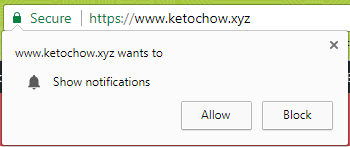
The Notifications in Chrome look like this. They’ll show up whenever a new blog post goes up on the site:

If you want to stop them, it’s super easy and you can do it in several ways. In Chrome, you can click on the little gear that’s right by the close button on the notification. That’ll take you to chrome://settings/ where you can remove or block notifications from specific sites:

You can also click on the “Secure” lock immediately to the left of the address bar, and remove notifications for the specific site you’re on:
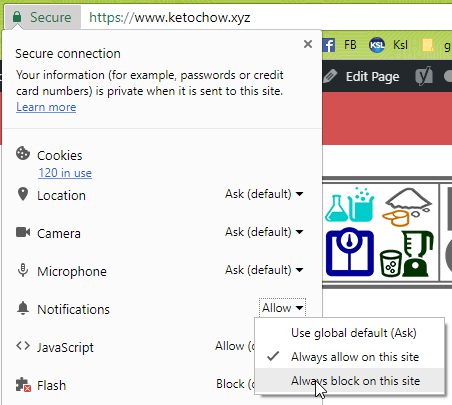
The instructions for Chrome on mobile devices has you doing the same things.
To remove notifications for a site in Firefox just follow these instructions, or just click the gear icon on a notification and turn them off:
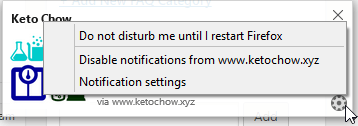
And here are the instructions for Safari.
Does my Keto Chow package indicate what’s inside?
We ship products in standard USPS Flat Rate boxes/envelopes or other shipping-grade parcels. As a result, the package itself doesn’t provide much information. For US shipments, there will be a “Keto Chow Order #Sxxxxx” at the bottom of the shipping label. International shipments will include a customs declaration, so you can determine what’s inside from that.
We declare Keto Chow as protein powder, and Base Powder as acacia gum. These are the primary ingredients in each, respectively. Inside the box, you’ll find a packing slip detailing the items and quantities within.
Why does international shipping cost so much?
The cost for international shipping is a direct relation to how much the US Postal Service (USPS) charges for shipping their Flat Rate packages. We’ve looked into UPS, FedEx, and DHL for international shipments and have encountered several problems:
- The recipient was liable to pay for the brokerage fees and customs duties when using a carrier other than USPS.
- Keto Chow does weigh quite a bit, and it’s quite large physically. That makes for an expensive “cubic weight” shipping fees. Using flat-rate boxes reduces that greatly.
- All of the other carriers I’ve looked into charge more for international shipping compared to USPS.
The solution to many of these is to branch out with local international distributors. We’ve started with Canada, and seen some success. If you know of any importers or distributors in your region, contact us with their information. We’d be happy to reach out to them.
In the meantime, check out our Base Powder, designed for international customers who want to save on shipping. It has everything but the protein (the #1 ingredient by weight and volume), flavor, and sweetener. I have some additional details and info about the Base Powder on this page. When mixed with the right amount of protein powder, you’ll end up with 21 meals of Keto Chow.
What is the return policy?
If there is a problem with your order or if you would like to return your Keto Chow for any reason, please contact us! We will take care of you and make things right. We stand by our product, but we understand that everyone has different needs and preferences.
Please note that purchases made for resale are not eligible for return or refunds, as they would fall under our wholesale agreement. For more information on wholesale, use the contact information below.
Please email orders@ketochow.xyz or call 385-645-5386 to speak to a member of our customer service team (a.k.a. a real life human being) based in our Draper, UT warehouse. Please contact us within 90 days of your purchase.
Where can I buy Keto Chow? Do you have a physical store?
You can buy Keto Chow online at https://ketochow.xyz/
If you happen to be nearby Draper, UT, feel free to come by our warehouse in person.
Keto Chow
12577 South 265 West, Unit 4A
Draper, UT 84020
We’re open Monday-Friday, 8:00 AM-5:00 PM
Why is Keto Chow not on Amazon?
Actually, it is! Check out Keto Chow on Amazon to purchase individual samples, sample bundles, 21-meal bags, and electrolyte supplements. In addition, our products are eligible for Prime shipping.
Why can’t some items be shipped to my address?
The shopping cart has rules to determine shipping costs. If you have too many items in your cart you may get a message telling you stuff can’t be shipped. Please contact us with the details – usually, it’s a bug Chris can easily fix.
Why does my zip code keep failing validation? Why do I have a bunch of charges from you?
The credit card verification we use is pretty strict. Since November 2015, we’ve never had a chargeback or fraudulent transaction. Your billing address has to exactly match what your credit card company has on file. If in doubt, pull up your card statement and see where they think you live.
If it fails to verify you might still see an “authorize” transaction on your card. This is from Stripe (our processor) saying:
“Hey, does this person have enough money to cover the charge? Cool, here is their address, does it match what you have? No? OK, never mind.”
If it does match then it does what’s termed a “capture” transaction. This is where they charge your card for realsies.
So the good news is: you aren’t charged for the auth transactions, but they do temporarily count towards your credit limit. After a few days, depending on the bank, the pending charges will drop from your account. If you need it, you can sometimes call the bank and get them to release an auth transaction early.
Do you ship to (insert country here)?
Likely, yes! Unfortunately, we can no longer ship to the UK due to VAT requirements. Other than that, we should be able to ship to any place the US Postal Service ships. Our shipping charges correspond directly to the USPS rate based on weight, country, and package size. Shipping is calculated at checkout based on the contents of the order.
If you are an international customer, you may want to consider Keto Chow Base Powder. It’s designed specifically to provide the vitamins and minerals in Keto Chow shakes, but without the heavy protein powder. This means it weighs less and therefore is cheaper for international consumers.
General Product Info:
How does Keto Chow compare to OptiFast®?
The first thing you may notice is the far higher carbohydrates in OptiFast® (15g of net carbs per serving). The high carb count would be because the very first ingredient is maltodextrin—an ingredient that is frequently avoided by keto-ers. Per calorie, Keto Chow provides far more protein, better vitamins and minerals when compared to OptiFast®.
When will flavor X be available? Will limited edition Y come back in large bags?
We haven’t yet made an announcement about the availability of that flavor in that size. Because of the MANY factors beyond our control that determine when stuff will actually be available we simply do not make any announcements about if, or when, different flavors will be coming until they have actually arrived at our warehouse and have been quality tested. Introducing new flavors and new sizes of limited edition flavors is a months-long process dependent on the schedules of many outside groups. We could anticipate that something will take 2 months and it will actually take 9 months, or it may only take 3 weeks.
When it’s ready, we WILL let you know!
Does Keto Chow have Canola Oil or Sunflower Oil in the ingredients?
The short answer: It’s on the ingredients but not in the actual packaged product.
OK, that’s a weird answer, right? Here’s the full explanation: many of the flavors of Keto Chow use spray-dried flavorings and the machines that are used to spray dry them need to be lubricated with oils. Due to food regulations, edible oil (as opposed to something like WD-40) has to be used just in case any makes its way into the final product (you even see this in the giant crushers used by RealSalt® – the grease they use is totally human edible). In practice, there should be 0.00% of the oils in the flavoring and technically we don’t actually have to declare any of these oils on the ingredient list of Keto Chow, but that isn’t how we do things around here. We always try to be open and honest, the way we wish ALL companies acted. We get a lot of complaints about canola or sunflower oil being listed on the ingredients of a few of the flavors and that is due to our desire to be completely open with everyone instead of hiding. It is far better to just eliminate those contentious ingredients from the manufacturing process. We are currently in the process of changing the process to use MCT oil instead of any other oil.
So yes, they are listed on the ingredients. We totally could have just said “natural flavors” and nobody would have ever known…except us, and we don’t want to risk exposing someone that’s allergic to an ingredient.
What are the size options for Keto Chow?
We make just 2 sizes of Keto Chow:
- Individual Meals – great for sampling the different flavor options that are available. We also have these in several pre-made bundles of specific flavors. They cost around $5.50 per meal.
- Single-Flavor, 21-meal Bulk Bags – designed to be efficient and inexpensive. Once you’ve tried the different flavors and found what you like, these give you the most cost-effective way to order. They cost around $4.28 per meal “off subscription” and can get as low as $3.42 per meal if you get them with a subscription!
We don’t make any other sizes, there isn’t a 3-meal pack or a 10-meal pack. Adding more sizes complicates the product, and would raise the price of Keto Chow.
Want more variety? You can buy several different flavors of the individual meals (which is more expensive), or the larger 21-meal bags and pull from all of them as desired. This costs more up-front, but so would purchasing 21 full meals of any food. Especially one that’s so densely packed with nutrition.
Why do you have a scoop in EVERY package? Can I opt to not have it included?
Unfortunately, the logistics of having “no scoop, please” as an option would RAISE the cost of Keto Chow.
The scoop costs us $0.05 to have included with every bag. It would initially save a little to not include them. However, accidentally forgetting to include one, then needing to ship one to a customer wipes out any savings. The postage, paying employees, and the rest of the fulfillment process costs money. Most importantly, the delay sucks for the customer.
Including the scoop simplifies the fulfillment process, and saves us far more than the cost of the scoop. This is why you can’t customize sample bundles – they’re pre-made at substantial savings, ready to go right into your order. Simplicity = savings!
Another issue: a loose scoop outside a bag presents something that could puncture the bags of Keto Chow. Suddenly, that 5-cent scoop has destroyed a far more expensive bag that we need to replace. Replacements blow away much of the cost savings and optimizations we’ve put in place. Our amazing, non-robot, actual-human workers would have to perfectly fulfill approximately 2000 orders with no packages damaged in shipping (thanks UPS!) for not including the scoop to be financially beneficial.
So, a long response to a simple question. The short version is: it’s easier and cheaper to include them in each bag. Thanks for the suggestion.
Can I give Keto Chow to my child? Is it safe to use while pregnant or breastfeeding?
Legally speaking, we cannot recommend Keto Chow for children, pregnant, or breastfeeding women, as it has not been evaluated for those specific groups by the FDA. We do have employees, friends, and customers who have used it in these circumstances, but if you have any reservations at all, it is best to show the nutrition and ingredients to your healthcare provider and discuss it with them.
What is your most popular flavor?
Chocolate is, by far, the most popular flavor.
Every so often, we publish a list of our online best sellers on our blog. You can view the most current leaderboard of our most popular flavors here.
Is Keto Chow safe to use during pregnancy or while breastfeeding?
The only official statement we can legally give is the disclaimer at the bottom of the Keto Chow site:
The content of this website is not intended for the treatment or prevention of disease, nor as a substitute for medical treatment, nor as an alternative to medical advice. Use of recommendations is at the choice and risk of the reader. If you are on any medication, please consult with your family doctor before starting any new eating plan. Keto Chow is not intended to treat, cure or prevent any disease. Pregnant or breast feeding women should consult their health care professional before consuming.
Take a printout of the nutrition and ingredients to your doctor and have a discussion with them. Not a “sit there and listen to them” but working together to determine what will work for you. To my knowledge, there’s nothing specific to Keto Chow that would be any more detrimental to mother or child than a typical keto diet. The real question to ask is the safety of a keto diet during your pregnancy/nursing. The internet is not the place to make that determination. The only issue we have heard reported is: don’t use MCT oil while nursing. Not that it is bad – it just tends to make babies mad. There are some amazing resources over on Reddit Keto Babies.
How does Keto Chow compare to other “meal replacements” like Pruvit Keto//OS?
The aim of Keto Chow is to be nutritionally complete with 1/3 of ALL your nutritional requirements. This includes vitamins, electrolytes, protein, fat, fiber…ALL of it.
Keto//OS is a mixture of exogenous ketones. You drink it and you’ll have ketones in your body regardless of actually being in nutritional ketosis or not. For people doing keto to treat a disease like epilepsy, cancer, or Alzheimer’s; or for people doing elite-level athletics – exogenous ketones can be very useful. For most of us, they’re of limited use. You’re not “in ketosis” unless your body is producing ketones by itself. If you do want to use exogenous ketones, I would recommend checking out Perfect Keto or other products not sold via Multi-Level Marketing.
If you’re curious, I’ve compiled a comparison of the various Keto “Meal Replacement” products available, which you can find here.
Keto Chow is at the top with a cost of around $11 per 2000 calories. Keto//OS is at the very bottom at $250.00 for 2000 calories.
There is a more in-depth analysis of the different options on our 2018 blog post.
What is the shelf life of Keto Chow? How long does an opened bag of Keto Chow last?
The shelf life of unopened Keto Chow is 5 years. The packages produced prior to 2023 have a printed “best by” date of 2 years, meaning that if your package has a best by date prior to 2027, you can confidently add 3 additional years to the date shown. The 5-year stability tests were performed as a “real-time” test meaning that we had older packages of Keto Chow tested to ensure their nutritional content was still accurate.
The primary factor determining how long an opened bag of Keto Chow will last is humidity. If you live in an arid climate, you may have bags that are still fresh and tasty after 4-5 months. If you live in humidity, the powder may get clumpy and spoil after only a few days.
There are a few things you can do to combat the humidity:
- Use desiccant packets (the “DO NOT EAT” things you find in stuff)
- Store your bags in the freezer, not to keep them cold but because freezers tend to be crazy low humidity, and the cold doesn’t hurt either
- Get smaller bags or split up the large bag into smaller bags
What are the differences between Keto Chow version 1.5 and 2.0+?
There are several key differences between 1.5 (the version you can make yourself) and 2.0+. Some are also differences from 1.5 to 1.9.
- A custom-made vitamin and mineral pre-mix. This replaces several ingredients (the vitamin pill, Calcium Phosphate, Vitamin K, Choline L-Bitartrate, Calcium/Magnesium Citrate, Vitamin D3). There’s also more Magnesium. Other vitamins and minerals have also been adjusted above minimum levels to optimal levels, and optimal forms for bioavailability.
- Additional Potassium to comply with the new US dietary requirements.
- Better Magnesium source that makes is a lot easier on digestion.
- Protein Isolate which has significantly lower carbohydrates compared to the concentrate/isolate/hydrolyzed protein blend used in 0.7-1.9. Most flavors are only 0.56g net carbs before adding any heavy cream.
- Custom made flavors. Earlier versions used off-the-shelf protein powder with flavoring. Using our own makes the flavors more stable and lowers the cost.
- Eliminated 2 sweeteners: AceK and Stevia
- Mixed and packaged in a different facility. All of the flavors (except Chocolate Peanut Butter) are now completely peanut-free and safe for people with peanut allergies.
Do I have to drink Keto Chow for 3 meals a day?
Nope! Keto Chow was designed to provide complete nutrition so that you could live on three a day if you wanted to, but there’s no reason you have to. Many users do 1-2 Keto Chow meals a day, with keto-friendly meal(s) to provide the rest of their daily calories. You can also use it just occasionally on especially busy days—whatever works best for you.
What is Keto Chow?
Keto Chow is the tastiest low-carb meal replacement shake mix on the market and is designed to support nutritional ketosis. Combine it with a fat source of your choice (like heavy cream, butter, or oil) and water. One shake provides 1/3 of your daily vitamins, minerals, fiber, protein, electrolytes, and more.
Nutritional/Dietary:
What is the Amino Acid Content of Keto Chow Core? Does it have enough Lysine?
We are very happy to publish the complete amino acid content for Keto Chow Core—we even added a total for the branched-chain amino acids. There has been some concern of late about the lysine content of beef protein isolate and if it is sufficient for muscle gain.
Fortunately, there is a great peer-reviewed study where beef protein isolate was compared to whey protein and chicken. The short version of the results is that despite the different amino acid compositions (specifically lysine), the higher conditionally essential amino acids gave essentially the same results for beef isolate compared to whey and “suggests the need to evaluate proteins based on total nutritional potential rather than as a delivery vehicle for single amino acids.” Fun stuff. =)
You can read the full text of the article here.
| Amino Acid | Per Serving | Percentage |
|---|---|---|
| Alanine | 2.46 g | 8.87% |
| Arginine | 2.1 g | 7.56% |
| Aspartic acid | 1.68 g | 6.04% |
| Cystine | 0.03 g | 0.1% |
| Glutamic acid | 3.08 g | 11.08% |
| Glycine | 5.6 g | 20.15% |
| Histidine | 0.31 g | 1.11% |
| Hydroxyproline | 2.86 g | 10.28% |
| Isoleucine | 0.48 g | 1.71% |
| Leucine | 1.04 g | 3.73% |
| Lysine | 1.06 g | 3.83% |
| Methionine | 0.25 g | 0.91% |
| Phenylalanine | 0.64 g | 2.32% |
| Proline | 3.36 g | 12.09% |
| Serine | 0.95 g | 3.43% |
| Threonine | 0.59 g | 2.12% |
| Tryptophan | 0.1 g | 0.36% |
| Tyrosine | 0.36 g | 1.31% |
| Valine | 0.84 g | 3.02% |
| Total Amino Acids | 27.79 g | |
| Branch Chain Amino Acids | 2.35 g |
Does Pecan Sticky Bun Keto Chow contain nuts?
There are 6 different flavorings in Pecan Sticky Bun Keto Chow, and all of them are listed as having no allergens present. We wanted to make absolutely sure what that exactly meant so we had an allergen statement created specifically for the Candied Pecan flavor since it was the most likely to be problematic for people allergic to tree nuts.
According to the manufacturer of the flavoring used in Pecan Sticky Bun Keto Chow, there are no nuts present. There are nuts and other allergens present in the facility where the flavoring is manufactured and the flavoring is processed on the same equipment after a VERY thorough cleaning is performed (this is pretty standard stuff).
Here is the full allergen statement for the Candied Pecan flavoring:

Does Keto Chow contain Uncaria tomentosa?
Keto Chow does not contain Uncaria tomentosa, also known as “Cat’s Claw.”
A recent case study involved a “Keto Shake” with Uncaria tomentosa that caused kidney problems – this was not Keto Chow.
Macros on Keto; how much protein, fat, and carbs should you have?
Carbs are an upper limit, meaning do not go higher than that. You want to be as far below them as possible, approaching zero if you can.
You want to hit your protein goal. If you go over it, that’s not a big deal. There’s a thing in your body that can turn protein into glucose but it’s DEMAND driven, not supply driven, and so long as you’re keeping your carbohydrates low, your insulin will be low as well and too much protein isn’t something to be concerned about. Too little protein is a problem. A lot of people argue about this but Dr. Benjamin Bikman settled the debate back in 2018
Fat is more variable. If your insulin is low then your body will be able to supply fat using your body’s reserves (yay!). If you are just starting keto then your insulin is likely high enough that the fat is locked away and you will not be able to access it readily. Here’s the rub: you’re not eating carbs so you don’t have glucose; but you also can’t access stored fat so unless there’s sufficient fat on your plate, your cells will not have any sources of energy and you’re going to get hungry. Probably REALLY hungry and think this keto thing is a pack of lies. The solution is to make sure you are getting sufficient fat until your body figures out what it’s doing and can pull from storage. Especially when you’re starting up the amount of fat you’re eating. Throw some extra butter on your steak, add some more heavy cream to your diet root beer, etc… After you’ve adjusted, then you can start running a caloric deficit but you’re probably not even going to need to deliberately do it since your body should clue-in and tell you “nah, I’m full – save that for later”
Finally: this cannot be emphasized enough: get salt. Like: a lot of salt. Not to be melodramatic but everything you’ve been told about limiting salt consumption is dead wrong and has no application to a ketogenic diet with low insulin levels. Salt your food. Salt your drinks. Eat some pickles. Drink some pickle juice. Make some chicken broth. Add more salt to your food. Failure to get enough salt will result in you feeling like crap and getting “Keto Flu” – I can speak from experience.
From the Reddit Keto FAQ
What are macronutrients?
Macronutrients (“macros”) are what you use for fuel: fat, protein, and carbohydrates. Every weight-loss diet works by limiting the total amount of calories you eat. The macronutrient makeup of a ketogenic diet make it very easy to stay in a caloric deficit and lose weight. Most people do not need to count calories on that diet, because they naturally start consuming a healthy amount of calories.
The three macronutrients are carbohydrate, protein and fat.
All three nutrients have differing effects on ketosis due to their digestion and subsequent effects on blood glucose and hormone levels.
- Carbohydrate is 100% anti-ketogenic due to its effects on blood glucose and insulin (raising both).
- Protein is approximately 46% ketogenic and 58% anti-ketogenic due to the fact that over half of ingested protein is converted to glucose, raising insulin.
- Fat is 90% ketogenic and ten percent anti-ketogenic, representing the small conversion of the glycerol portion of triglycerides to glucose.
“Both protein and carbohydrate intake will impact the development of ketosis, affecting both the adaptations seen as well as how much of a ‘protein sparing’ effect will occur. Despite the generally ‘high fat’ nature of the ketogenic diet, or at least how it is perceived, dietary fat intake has a rather minimal effect on ketosis per se. Fat intake will primarily affect how much bodyfat is used for fuel.”
Lyle McDonald, “The Ketogenic Diet”, page 52
Compared to the diet recommended by the US Food and Drug Administration, the macros in a ketogenci diet are high fat, moderate (adequate) protein, and extremely low in carbohydrates.
How do these 3 macronutrients give energy to our body?
Alcohol is also a macronutrient and it may have applications in explosive exercises, however, due to the small, infrequent levels in which it’s consumed, it is rarely referred to when calculating nutritional goals. That’s not to say that alcohol can’t affect ketosis. Refer to http://www.reddit.com/r/keto/wiki/faq#wiki_can_i_still_drink_alcohol.2Fcoffee.3F.
Protein and the Ketogenic Diet
Although carbohydrate intake is arguably the most important aspect of successfully inducing ketosis, protein intake is extremely important in order to prevent muscle loss. While an easy solution is to simply eat as much protein as possible, this is not recommended.
Therefore, protein intake is recommended to fall within a narrow range:
- Sedentary people: 0.69 – 0.8g per lean pound
- Mildly active or doing endurance / strength training: 0.8 to 1.0g per lean pound
- Heavy strength training / bodybuilders: 1.0 up to 1.2g per lean pound
Protein according to lean pound is recommended for people who are obese or want to achieve low body fat levels.
For the most part, the timing of protein intake is not an issue on a ketogenic diet, except as it pertains to maintaining ketosis. The nature of the ketogenic diet ensures that protein is consumed at most meals with few exceptions.
Do I need to hit my fat macro?
If you are doing keto for weight loss, no. A common misconception about the keto diet is that one must consume a lot of fat. The keto diet is a high fat diet, but if you are doing keto for weight loss a portion of that fat is going to come from your body. You may commonly see it said on this subreddit that fat is a lever/meant to keep keep you full. Your body can’t get all of its energy from stored body fat though, so be sure to consume at least 30g-50g of fat per day.
If you are doing keto and struggling to lose weight, fat is the first thing that should be cut. This article is a good place to start for ways/reasons to reduce your fat intake.
A macros tl;dr:
Carbs are a limit. They are the only macro that meaningfully impact ketosis. There is no minimum carb intake.
Protein is a goal. Protein is vital. Unlike carbs and fat your body cannot store protein. This is why you need to prioritize hitting your protein macro every day.
Fat is to satiate. Fat is what you use for energy on a ketogenic diet, but if you’re trying to burn body fat you don’t need to hit your fat macro. Just eat enough of it so that you feel full.
I don’t want to add a lot of fat, what is the minimum fat I can add to Keto Chow?
The minimum amount of fat you need to absorb the fat-soluble vitamins in Keto Chow is approximately 30g of fat a day, or around 10g of fat in each serving of Keto Chow.
Does the Black Licorice Keto Chow contain actual black licorice extract?
Yes, it does. If you are allergic or have an adverse reaction to real licorice, we would recommend avoiding the Black Licorice flavor Keto Chow.
Black Licorice also contains a naturally occurring compound called “glycyrrhizin” that, if consumed excessively, can cause depletion of potassium. OK, so what do we mean by that? The FDA recommends “If you’re 40 or older, eating 2 ounces (60g) of black licorice a day for at least two weeks could land you in the hospital with an irregular heart rhythm or arrhythmia.” The Black Licorice flavor of Keto Chow uses 2g of licorice flavoring. Let’s take the worst-case scenario and assume that the entire 2g is actual licorice, to get the 60g the FDA warns about, you would need to consume 30 meals of Keto Chow A DAY for 2 weeks. That’s 780g of protein and it’s frankly, not going to happen.
Does Keto Chow have Canola Oil or Sunflower Oil in the ingredients?
The short answer: It’s on the ingredients but not in the actual packaged product.
OK, that’s a weird answer, right? Here’s the full explanation: many of the flavors of Keto Chow use spray-dried flavorings and the machines that are used to spray dry them need to be lubricated with oils. Due to food regulations, edible oil (as opposed to something like WD-40) has to be used just in case any makes its way into the final product (you even see this in the giant crushers used by RealSalt® – the grease they use is totally human edible). In practice, there should be 0.00% of the oils in the flavoring and technically we don’t actually have to declare any of these oils on the ingredient list of Keto Chow, but that isn’t how we do things around here. We always try to be open and honest, the way we wish ALL companies acted. We get a lot of complaints about canola or sunflower oil being listed on the ingredients of a few of the flavors and that is due to our desire to be completely open with everyone instead of hiding. It is far better to just eliminate those contentious ingredients from the manufacturing process. We are currently in the process of changing the process to use MCT oil instead of any other oil.
So yes, they are listed on the ingredients. We totally could have just said “natural flavors” and nobody would have ever known…except us, and we don’t want to risk exposing someone that’s allergic to an ingredient.
When the ingredients in Keto Chow say “natural” or “artificial” colors are used, what does that mean?
In the simplest terms, a “natural” ingredient means it is derived from something found in nature. However, “natural” does not mean “better” — it’s simply a way to designate the origin. An “artificial” ingredient means that it’s created by combining compounds together. Keto Chow uses both natural and artificial ingredients, but we always prioritize health and quality.
What is the Glycemic Index and Glycemic Load of Keto Chow?
First things first, you need to understand how the Glycemic Index is measured in foods:
GI values of foods must be measured using valid scientific methods. It cannot be guessed by looking at the composition of the food or the nutrition information panel on food packaging.
Following the international standard method, the GI value of a food is determined by feeding 10 or more healthy people a portion of the food containing 50 grams of digestible (available) carbohydrate and then measuring the effect on their blood glucose levels over the next two hours. For each person, the area under their two-hour blood glucose response (glucose AUC) for this food is then measured. On another occasion, the same 10 people consume an equal-carbohydrate portion of the sugar glucose (the reference food) and their two-hour blood glucose response is also measured. A GI value for the test food is then calculated for each person by dividing their glucose AUC for the test food by their glucose AUC for the reference food. The final GI value for the test food is the average GI value for the 10 people.
Foods with a high GI score contain rapidly digested carbohydrate, which produces a large rapid rise and fall in the level of blood glucose. In contrast, foods with a low GI score contain slowly digested carbohydrate, which produces a gradual, relatively low rise in the level of blood glucose.
OK, so we give 10 people a portion of food containing 50g of digestible carbohydrates. Depending on the flavor of Keto Chow, that varies. Let’s use Salted Caramel for the following illustration. Each 44.8g serving of Salted Caramel Keto Chow has 0.50g of non-fiber carbohydrates. That means we would need to give our test subjects exactly 100 servings of Keto Chow to get the 50g. Each of the 10 participants in the study would need to consume 4.480 kg (9.87 pounds) of powder, equaling 11,800 calories, mostly of protein. In a liquid form, mixed with half a stick of butter per serving, you would need the same 100 servings but you would now be consuming 55,000 calories with a volume of 15.6 gallons.
Because our product is designed for a ketogenic diet, the standard method for measuring the Glycemic Index doesn’t actually even work! We would need to give people such an absurdly large quantity of Keto Chow – I’m sure it would be deemed unethical. Calculating the Glycemic Load needs the Glycemic Index. With both figures, it can reasonably be said that they are below the measurable threshold.
Redmond Real Salt in Keto Chow: why there’s a little bit of sand at the bottom of your bottle
Starting with version 2.5.2 of Keto Chow (full changelog here), we switched to using Redmond Real Salt in Keto Chow.
- Real Salt tastes better than standard table salt.
- Real Salt is mined in Utah, just a few hours away from Keto Chow HQ.
- Real Salt has a lot of cool trace minerals that add to the flavor.
- …but Real Salt has a lot of cool trace minerals. Some of that shows up like sand at the bottom of your container as they do not readily dissolve.
So, lots of pros, with that one con. If it bothers you, you can let them settle for a minute and leave the last bit of your shake in the glass or bottle.
What allergens are in Keto Chow? Does Keto Chow have tree nuts?
Ingredients are available on each product’s page. A list of some common allergens are below. Please note, we cannot guarantee that this list reflects all flavors or allergens. If you have concerns about any allergen, please contact us at 385-645-5386 or hello@ketochow.xyz and we will speak to our suppliers to ensure we have the most accurate information possible.
Common Allergens
Gluten and wheat
- All flavors of Keto Chow are gluten-free and wheat-free.
Soy
- All flavors of Keto Chow are soy-free.
Peanuts
PLEASE NOTE: All Keto Chow is manufactured at the same facility. However, after processing flavors that do contain peanuts, the facility is cleaned according to FDA guidelines to prevent cross-contamination.
- Chocolate Peanut Butter
- Peanut Butter
Tree Nuts
(almonds, hazelnuts, walnuts, brazil nuts, cashews, pecans, pistachios and macadamia nuts, etc…)
Nutmeg
- Apple Pie
- Chai Latte
- Eggnog
- Pumpkin Spice Caramel
Aside from nutmeg, all flavors of Keto Chow are tree nut-free (including the pistachio which does not have pistachios in it). Pecan Sticky Bun does not contain tree nuts.
Dairy
- Dairy-free options are available. Keto Chow Core, Base Powder, Creamy Tomato Basil, Spicy Taco Soup Base, and Beef Soup Base.
Eggs
- Eggnog
- Egg White Protein
Other Allergens
Cinnamon
- Snickerdoodle
- Pumpkin Spice Caramel
- Apple Pie
- Pecan Sticky Bun
- Gingerbread
Tomatoes
- Creamy Tomato Basil
- Spicy Taco Soup Base
Fish
- All flavors of Keto Chow are fish-free.
Lupin
- All flavors of Keto Chow are lupin-free.
Shellfish and Mollusks
- All flavors of Keto Chow are shellfish-free.
Sesame
- All flavors of Keto Chow are sesame-free.
Pineapple extracts
- Pina Colada
Allspice
- Apple Pie
- Chai Latte
- Gingerbread
- Pumpkin Spice Caramel
Coffee
- Caramel Macchiato
- Irish Cream
- Mocha
Cardamom:
- Apple Pie
- Chai Latte
Ginger:
- Gingerbread
- Pumpkin Spice Caramel
Cloves:
- Gingerbread
Basil:
- Creamy Tomato Basil
Is Keto Chow “Organic”? Is Keto Chow “GMO”-free?
The short answer is no. But here’s why:
The primary goal of Keto Chow is very simple: simply and easily get the best nutrients for humans and make eating a ketogenic diet more enjoyable and sustainable. All of the decisions we make, including which ingredients we use, derive from that goal. We are more interested in using the best, most nutritious ingredients than using ingredients that would qualify to be certified organic. It would be a disservice to our customers that rely upon us for the highest quality nutrition possible to show more concern for the label than for the actual effect those ingredients will have.
We understand that products that are certified “organic” or “GMO-Free” is important to many people. Caring about your health is a great thing! Our research directs us to put actionable data and science above philosophy. This, unfortunately, means that if you only purchase “organic” products, this isn’t the best option for you.
Are there any dairy-free options? Can Keto Chow be dairy-free?
Yes! Check out the Keto Chow Core line for dairy-free options.
Can you use Keto Chow while doing intermittent fasting?
Yes! Time-restricted eating is another name for intermittent fasting. You limit your mealtimes to fall within a designated window, and fast outside that window. You can use Keto Chow as a meal replacement during one (or more) of your scheduled meals or eating windows.
Does Keto Chow have a low-sodium option? Is that much sodium bad for you?
Keto Chow is designed to provide 1/3 of what your body needs in every serving—including sodium.
In fact, many people on keto, especially as they are first starting out, don’t get enough sodium. This can result in imbalanced or low electrolytes, causing flu-like symptoms. (This is sometimes called the keto flu.)
Many find they feel their best by adding sodium above and beyond what Keto Chow has. You can check out our other keto supplements to get the extra electrolytes you need.
What can I do if I want all my daily calories in two Keto Chow meals?
Some simple math will solve this dilemma. Take your daily calorie target and divide it by two. You can then use our How To Chow graphic (down below). This will help you determine how much fat you need for half of your daily calories in one shake.
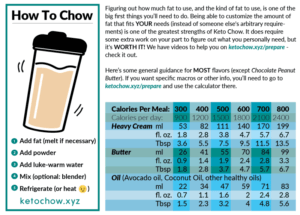
Can you use Keto Chow without doing a keto diet?
Yep! At its core, Keto Chow is a low-carb meal replacement shake. It also just happens to be 1/3 of everything you need in a day…and also super convenient.
Does Keto Chow contain nickel or boron?
In May 2018, we removed Nickel and Boron from the vitamin/mineral formulation of Keto Chow. You’ll find this change on the Keto Chow Change Log where we publicly list what we’ve changed in each revision of Keto Chow.
Nickel and Boron both *might* be necessary for good health (see this article), but there are no clear results that can be looked at for absolute certainty.
Why do Nickel and Boron remain on the ingredients list? There is still a chance people could get one of the old bags. We would rather lose a potential customer than make those who are allergic to nickel ill. We’ll list it on until ALL of the product we have on-hand has switched to version 2.1.2 or newer.
Does Keto Chow contain caffeine?
Most flavors of Keto Chow do not contain caffeine. The exceptions are below, with the amount per serving listed.
- Mocha – 110 mg. (from coffee powder, added caffeine, and cocoa powder)
- Chocolate (Classic and Core) – 9.2 mg. (from 4g of cocoa powder)
- Chocolate Mint – 3.45 mg. (from cocoa powder)
- Irish Cream – 2.5 mg. (from coffee powder)
- Caramel Macchiato – 0.93 mg. (from coffee powder)
Learn more about our label transparency here.
If you need to lose fat you already have stored, why do you need to add fat to Keto Chow?
Despite being viewed by some as the “bad” macro, fat is essential for your body. Even aside from its necessity in biological processes, it also plays an important role in making sure you stay full—making it less likely that you will overeat and consume extra calories. It’s what makes low-carb eating sustainable. Without enough fat to keep you full, your body will not be able to maintain this way of eating. Especially in the transition to keto, consuming extra fat helps your body learn how to burn fat for fuel instead of the carbs that it’s used to. I suggest thinking of it like this: on keto, keep carbs low, make sure you reach your recommended protein goal each day, and then add fat to satiety.
Why use a “chemical” sweetener like sucralose? Why not stevia, monk fruit, or erythritol?
First things first: there is some confusion between “Splenda” (that you buy at the grocery store) and pure sucralose. Splenda uses bulking agents so that you can “measure it like sugar” – typically this will be 99.8% maltodextrin which is simply a carbohydrate and no good for a Ketogenic or low carb diet. The maltodextrin in store-bought Splenda will absolutely spike your blood sugar. Pure sucralose, on the other hand, will not. Even if it did have an effect on blood sugar, there is simply too little of it to have any effect. In Keto Chow, we use 0.08g per serving. To put that in perspective: that is 1/64 the weight of a US nickel. Even 0.08g of actual sugar will only raise your blood sugar by 0.32mg/dL – essentially no effect.
You may also find people snidely referencing sucralose as “chlorinated sugar” – assuming that any form of chlorine is bad for humans. This would be ignoring Sodium Chloride (salt) and other essential chemical compounds that contain chlorine.
OK, back to the question of why we use sucralose for many of the sweet flavors of Keto Chow. The short answer is: because stevia doesn’t taste very good to the overwhelming majority of our taste testers. Ultimately, stevia, monk fruit, erythritol, or any other “natural sweeteners” are not magical and cause the same reactions in humans as anything else that’s sweet so why not use the best tasting option? We actually paid a 3rd party to do a blind taste test and they confirmed that Keto Chow with sucralose tastes “more natural” than products using Stevia, Erythritol, or Monk Fruit.
- Erythritol and Allulose would seem a good choice but they DOUBLE the weight and volume of Keto Chow, instead of 21 meals you’d get 10 for the same price and shipping. That sucks.
- Keto Chow CORE is available with either NO sweetener (add your own!) or with Stevia
- We do have the “Natural Strawberry” that does use monk fruit instead of sucralose. It costs more to produce and doesn’t taste as good (in my opinion).
- We have the “Base Powder” version which you combine with your choice of flavored/sweetened protein powder – lets you use whatever you’d like. Want to use egg white protein with Stevia? Go for it! You’ll still get all of the vitamins and minerals you’d normally get with Keto Chow.
- We have 4 savory soup flavors (you mix them hot!) that do not use any sweetener, because that would be gross.
Allow me to quote Julie from the Keto Village Facebook group – she illustrates why we use sucralose really well:
Holy what the hell. Go buy Keto Chow. It is NO joke. I am not a packaged foods kinda gal but needed something to get me back on the Keto track. I was thinking, honestly, “ok, I can choke this down for a couple weeks.” Um. NOT EVEN CLOSE. This shiz is delicious!!! And easy to make! Holy wow!
I bought both the peanut butter chocolate and the raspberry cheesecake. I blended 1/2 c heavy cream and 1/2 cup coconut milk with ice with a scoop of chow. Thick like a milkshake. No weird malt “slim fast” taste.
(Chris here) I personally use Keto Chow for at least 2 meals a day, often 3. Instead of something that I have to suffer through, I want something so delectable that I’m sad when I run out. It should taste so good that I swish it around in my mouth, enjoying the flavor; not plugging my nose and chugging it as fast as possible. And I won’t sell something that’s gross or barely tolerable. It’s gotta be delightful and that’s what you get with sucralose: the best flavor possible. A meal replacement that doesn’t taste AMAZING isn’t helpful in its intended use.
What about the rat studies showing changes in gut bacteria when exposed to sucralose? Humans are not rats. Those rats weren’t consuming acacia gum. Those rats weren’t on a ketogenic diet. Even more important, is the DOSE that the rats received. The dosage is usually expressed in mg/Kg or how many milligrams of sucralose were given per Kilogram of body weight. In the US, it was estimated (top of page 3) that most people consume 98mg of sucralose per day resulting in a dose of 1.6mg/Kg. In a recent study to determine the effects of sucralose, the rats were given an average of 80.4 mg/kg. Let’s see how that compares to what *you* would get by consuming Keto Chow: Let’s assume a 180lb person, they would need to consume 82 meals of Keto Chow *A DAY* in order to get the level of exposure in that rat study. If you measure in KG the math gets really easy, a 75kg person would need 75 meals.
The Acceptable Daily Intake (ADI) level for sucralose was set at 5 mg/kg body weight per day (mg/kg/d) (page 10) in the US and 15 mg/kg/d in the EU. So you’d only be close to that using Keto Chow if you do it 3x a day and weigh 100lbs/45kg.
In a widely refuted study from 2016, researchers gave mice 62mg/kg of sucralose and claimed a connection to leukemia – the science on that paper was so poorly done, an entire paper was published taking it apart. If you ever see someone claim sucralose is implicated in cancer or leukemia, they are only reading the original sensational headlines and ignoring the later contrary published proof. A 180lb person would need 62 meals of Keto Chow a day to get the 62mg/kg dose from the study.
In a study published in May 2021, researchers exposed different bacteria to 3 artificial sweeteners (saccharin, sucralose, and aspartame) in Petri dishes (“in vitro”) and then measured their growth, how they formed colonies, and how effectively they can attack mammal intestinal cells. Of the 3 sweeteners tested, Keto Chow only uses pure sucralose. Saccharin modified bacterial growth and all 3 made it easier for the bacteria to form biofilms and to attack intestinal cells. Again, this was under laboratory conditions, not in living organisms – it also didn’t have the added benefits of acacia gum which are likely to erase all of the potential issues found.
One of the very interesting aspects of the study was the researchers also tested what would happen if a compound (zinc sulfate) that blocks sweet tastes was added. Adding this compound changed how the bacteria reacted, based on my reading of the study, that would indicate that it is sweetness causing many of the changes. If this is indeed the cause, that would likely indicate that ALL sweet substances would similarly affect the bacteria, including: stevia, monk fruit, sugar alcohols (like erythritol, allulose, xylitol, etc…), and regular plain sugar.
Unfortunately, the researchers stopped short of testing the logical next step which would be using “natural” sweeteners (including stevia, monk fruit, and actual sugar) as a control to contrast against, they only tested the 3 artificial sweeteners against no sweetener. Because there isn’t a legitimate control in the experiment, it’s currently not possible to derive any conclusions about whether artificial sweeteners cause substantially different results in humans compared to other sweet compounds. This is one of the reasons why it’s important that you not rely on the “news” version that’s been enhanced with incendiary headlines but actually read the full text of the published papers.
Similarly, there was a study in 2013 where researchers gave obese, insulin-sensitive individuals, who did not typically use sucralose, stevia, or monk-fruit either water or sucralose; then gave them 75g of glucose and measured their blood sugar response. The study notes that there are many non-nutritive sweeteners (sucralose, saccharin, aspartame, acesulfame potassium, neotame, stevia, and monk fruit) but they only tested sucralose. In fact, the study says “it has been demonstrated that the gastrointestinal tract (4,5) and the pancreas (6,7) can detect sugars through taste receptors and transduction mechanisms that are similar to those identified in taste cells in the mouth.” – that would indicate that monk fruit, stevia, allulose, etc… would be expected to have the same result as sucralose, since they are (plain and simple) sweet!
In 2023 a study was published where the researchers looked at a form of sucralose called “sucralose-6-acetate” which they found at typical concentrations of 0.5% in samples of pure sucralose. They performed a number of experiments where they tested sucralose-6-acetate in different concentrations and saw what it did to cells and DNA. They found that high concentrations caused changes in gene expression, intestinal barrier function (but only without typical intestinal bacteria), and breaks in DNA. The LOWEST concentration that problems were observed was at 353 micrograms per milliliter. Assuming their figure of 0.5% and taking a 0.08g dose of sucralose in a 600ml serving of Keto Chow, that would calculate to a theoretical 0.667 micrograms per milliliter in Keto Chow, that is 0.18% of the lowest experiment concentration that showed problems – or the experiment was 529.5 times higher than what is found in Keto Chow.
We do not recommend increasing the sweetener in Keto Chow by 529 times. That would be silly.
What sweeteners are used in Keto Chow?
Most flavors of Keto Chow use sucralose as the sweetener, but there are some exceptions. The savory flavors of Keto Chow (Savory Chicken Soup, Spicy Taco Soup, Beef Soup Base, and Creamy Tomato Basil) are unsweetened; Natural Strawberry uses monk fruit; and the Core line has an unsweetened option as well as one sweetened with stevia.
What are the differences between Keto Chow version 1.5 and 2.0+?
There are several key differences between 1.5 (the version you can make yourself) and 2.0+. Some are also differences from 1.5 to 1.9.
- A custom-made vitamin and mineral pre-mix. This replaces several ingredients (the vitamin pill, Calcium Phosphate, Vitamin K, Choline L-Bitartrate, Calcium/Magnesium Citrate, Vitamin D3). There’s also more Magnesium. Other vitamins and minerals have also been adjusted above minimum levels to optimal levels, and optimal forms for bioavailability.
- Additional Potassium to comply with the new US dietary requirements.
- Better Magnesium source that makes is a lot easier on digestion.
- Protein Isolate which has significantly lower carbohydrates compared to the concentrate/isolate/hydrolyzed protein blend used in 0.7-1.9. Most flavors are only 0.56g net carbs before adding any heavy cream.
- Custom made flavors. Earlier versions used off-the-shelf protein powder with flavoring. Using our own makes the flavors more stable and lowers the cost.
- Eliminated 2 sweeteners: AceK and Stevia
- Mixed and packaged in a different facility. All of the flavors (except Chocolate Peanut Butter) are now completely peanut-free and safe for people with peanut allergies.
Does Keto Chow contain all the Essential Amino Acids?
Depending on the flavor, Keto Chow uses either milk protein isolate or beef protein and beef bone broth. You can find the amino acid profiles for those on the Keto Chow nutrition page.
There are nine “essential” amino acids. Meaning, your body can’t synthesize them: phenylalanine, valine, threonine, tryptophan, methionine, leucine, isoleucine, lysine, and histidine. You can find all nine in both protein-types of Keto Chow.
Do women need to add or subtract any of the ingredients when making Keto Chow in order to lose weight?
Women do not need to make any changes or adjustments. Every user of Keto Chow simply adds fat to reach the number of calories they need.
Women may find that the Ladies on Keto Reddit have some really good resources and are super nice and helpful.
I have red streaks in my Keto Chow. What is that?
That’s the Vitamin A, encapsulated to keep it from oxidizing. After mixing, the capsule dissolves and releases the vitamins, resulting in red-colored streaks within the mixture. It’s completely safe and will go away with a quick shake.
Other meal replacements have a Prop 65 warning. Does Keto Chow contain heavy metals?
Some plant-based spices, like cinnamon and cocoa powder, contain enough lead to trigger a “reproductive harm” proposition 65 warning (if you consume 1000 times the amount it can cause birth defects). The flavors of Keto Chow that contain these spices (along with any food product that contains these spices) are required to have a Prop 65 warning. You can get more details about Keto Chow and heavy metal levels on this page.
Is Keto Chow safe for those with peanut allergies?
We mix and package Keto Chow in a peanut-free facility. We mix and package the Chocolate Peanut Butter flavor at a facility several miles away to avoid contamination. Therefore, Keto Chow is safe for peanut allergy sufferers (except for the Chocolate Peanut Butter).
How many calories are in a Keto Chow meal?
The number of calories in each meal depends on the amount of fat you add. Use the How to Chow graphic below as a guide for measuring with heavy whipping cream, butter, or avocado oil. You can also check out the Custom Calorie Calculator, and our preparation instructions page.

Are there any alternatives to fish oil?
You just need to find a suitable source for 1300mg of Omega 3 fatty acids. Most fish oil pills will advertise boldly how much fish oil they have. You have to look close to find the amount of EPA and DHA. With typical fish oil pills, you need 5 a day to get 1300mg. If you want to use a different source of Omega 3 (algal oil, krill oil, etc.), look closely at the label and do the math.
Does Keto Chow use potato starch?
Keto Chow does not contain potato starch or any resistant starch.
Is Keto Chow soy free?
It is! The earliest versions of Keto Chow contained soy lecithin. However, that has been replaced with sunflower lecithin, so Keto Chow no longer contains any soy ingredients.
Where can I get nutrition information and ingredients for Keto Chow?
You can view the nutrition facts and ingredients for the different flavors of Keto Chow on this page.
As far as allergens go, Keto Chow contains dairy and may contain peanuts or traces of peanuts.
Does Keto Chow contain any bananas?
No. The Banana flavor uses 100% artificial flavoring. Similar to banana-flavored Runt candy or Laffy Taffy, for example.
Can I use Keto Chow if I am lactose intolerant? Are there alternatives to heavy cream?
Many people who have problems with lactose are able to handle the relatively small amounts in Keto Chow without problems, or by using a lactase enzyme supplement. See this post for details.
In terms of what fat to add to your shake, heavy cream is relatively low in lactose per calorie, but you can also add butter, clarified butter, coconut oil, coconut cream, or avocado oil. You may also choose to add a small amount of MCT oil to another fat source, but we don’t recommend having it as your only fat source in your shake.
Can I get Keto Chow unflavored or unsweetened?
Yep! Check out our Keto Chow Core line and Base Powder.
Is Keto Chow gluten-free?
Yes, Keto Chow is certified as gluten-free.
Is Keto Chow Kosher? Is Keto Chow Halal?
Keto Chow is not certified as kosher or halal.
Is Keto Chow Vegetarian? Is Keto Chow Vegan?
Keto Chow shakes that use milk protein are not vegan, but are likely vegetarian. Keto Chow shakes that use beef protein are not vegan or vegetarian. Aside from the protein, there are a few other ingredients that vegans or vegetarians may want to take note of:
To the best of my knowledge, everything else is vegetarian aside from the beef protein.
What’s a good way to supplement additional protein to Keto Chow?
Most of the flavors of Keto Chow provide around 26g of protein per serving. If you’re looking to add additional protein for exercise, hitting a higher macronutrient target, etc. here are some ways to do so:
- You can mix additional low-carb flavored/unflavored protein powder, or collagen powder into your shakes.
- Or you can make some chicken breast, steak, bacon, eggs, etc. and eat it.
What’s up with all the saturated fat? Isn’t that bad for you?
I’m going to steal this one right from the /r/keto FAQ:
All foods containing fat – even pure oils – contain a mixture of three kinds of fat:
- saturated
- polyunsaturated, and
- monounsaturated.
We often identify foods by their predominant fat. For example, olive oil as “monounsaturated” butter as “saturated” – but all real foods contain mixtures of the three.
All three types of fats are necessary and important to human health. We should incoporate them into our diet in a balanced proportion. That’s the big question: What is balanced?
- Saturated fat, particularly in the absence of high carbohydrate intake, is not dangerous to human health. When balanced with mono and polyunsaturated fats in a controlled carbohydrate dietary environment, saturated fat has real and measurable benefits. You quickly oxidize saturated fat into energy, once you are keto adapted. So you can enjoy plenty of butter and animal fat guilt-free. Interestingly, coconut oil is something very different: it consists of Medium Chain Triglycerids (MCT) which your body cannot store. It has to immediately oxidize it. That means your body will immediately produce ketones, even when you are not keto-adapted. Nevertheless, this does not mean you’re getting all the metabolic advantages that you would get in a keto-adapted state.
- Monounsaturated fats (like olive oil) have well-known and well-documented benefits.
- Polyunsaturated fats, like vegetable oils, usually contain a lot of omega-6 and very little omega-3. The ideal ratio between omega-6 to omega-3 is 2:1 to 1:1. Generally, this ratio is often 20:1 or even worse. It is therefore important to avoid oils high in omega-6, like corn or soy. Vegetable oils rich in omega-3 contains it in the form of ALA which the body has to convert to DHA and EPA to be of any use. This conversion is highly inefficient. Therefore, ALA omega-3 rich vegetable oils like flaxseed oil or canola are no good either. The best way to get omega-3 is through fatty fish like salmon, or with a DHA + EPA supplement.
As a general rule of thumb, avoid fats high in omega-6. Also, run like hell from highly processed fat (anything that says “hydrogenated” or contains trans-fats) like margarine. Eat foods naturally high in fat like meat, fish, and nuts; use plenty of olive oil and butter. In fact, 50% butter with 50% olive oil approximates quite closely the composition of body fat. Meaning, this is the type of fat that the body can make best use off.
Keto Chow Preparation:
What’s the best way to mix Keto Chow Core?
Because of the change in ingredients, Keto Chow Core simply does not mix as easily as classic Keto Chow. If you’ve used classic Keto Chow in the past, you likely will need to adjust some of your expectations and procedures.
For best results, we recommend using very warm water (around 120°F/50°C) so it can properly dissolve the protein which tends to clump up in cold water like hot cocoa powder. If you try to use this temperature water in a blender bottle, it will build up pressure and eventually pop open the spout, so you’ll need to vent it to avoid that.
We recommend using a blender or immersion blender. You can mix Keto Chow Core using a shaker bottle, it’s just more difficult.
If you want to keep Keto Chow Core dairy free, you will likely want to use a source of fat that’s also dairy free, which means no heavy cream. Personally, I don’t think butter is really dairy since it has almost no dairy protein but you could use:
- Clarified butter/ghee (melted)
- Coconut oil (melted)
- Avocado oil
- Whole eggs (or egg yolks)
- Coconut cream
- Nut butters are a bit high in carbs but do work
- Actual avocado (use a blender!)
- Olive oil (has a very strong flavor most people do not like)
- Any other fat source you can think of
To activate the vitamins and minerals in Keto Chow, a minimum of 10 grams of fat needs to be added. Generally, we recommend you use far more than that minimum unless you have a very specific reason (and not just “fewer calories”).
My Keto Chow separated into layers/settled what happened?
Typically, there isn’t much settling or separation with Keto Chow. It may happen more with butter or coconut oil, especially if it was not melted completely before mixing, or if the water you used during mixing was not warm enough. On the other hand, water that is too hot (around 140 degrees Fahrenheit or more) can cause issues with the xanthan gum in particular. We recommend water that is around 100 degree Fahrenheit for best results. If you do notice some separation, just give it a quick shake! That’s it.
I don’t want to add a lot of fat, what is the minimum fat I can add to Keto Chow?
The minimum amount of fat you need to absorb the fat-soluble vitamins in Keto Chow is approximately 30g of fat a day, or around 10g of fat in each serving of Keto Chow.
Can you use Chia seeds as the fat source in Keto Chow?
This came up as a question in a live stream so we wanted to look at the details:
| Heavy Cream | Butter | Chia Seeds | Coconut Oil | Half and Half | |
|---|---|---|---|---|---|
| Amount | 1/2 cup | 1/2 stick | 1/2 cup | 1/4 cup | 1.25 cups |
| Calories | 405 | 407 | 388 | 486 | 396 |
| Total Carbs | 3.4g | 0g | 33.7g | 0g | 13g |
| Net Carbs | 3.4g | 0g | 6.2g | 0g | 13g |
| Fat | 42.9g | 46g | 24.6g | 54g | 34.8g |
| Protein | 3.4g | 0.5g | 13.2g | 0g | 9.5g |
OK, that looks like using chia seeds for your fat source would not be the end of the world, but a half cup to get 388 calories (514 when combined with Keto Chow) is going to likely do a terrible number on your digestive system (and will be a giant mess of chia pudding). Honestly, your better option is to use a different source. While we are on the subject, Half and Half is extremely high in sugar and not suitable for use in Keto Chow if you are interested in using it for a ketogenic diet. More information about that here.
Can I use “expired” Keto Chow?
The date on each Keto Chow package isn’t an “expiration” date, it’s a “best by” date.
Keto Chow contains various vitamins that are affected by time and oxygen (among other things, but those are the main detrimental factors), along with flavors and protein. The vitamins, in particular, start to lose their potency over time, and eventually, they end up being below the levels shown on the nutrition panel for Keto Chow. So nutrient “X” may be at, say, 130% level on the day it’s packaged, 100% level at 2 years, and 75% level at 4 years (again this is an example to illustrate). It’s not a linear progression and various nutrients have different degradation curves. If you want to ensure that you are getting the exact vitamin levels shown on the Keto Chow packaging, please consume it before the “best by” date. Once it is past that date, some of those vitamins may start to degrade. Because of that, we do not recommend using Keto Chow that is past the “best by” date as your sole source of nutrition for extended periods of time, but otherwise there should be no issue using it. (Around here, we use bags that are past their “best by” date and can therefore no longer be sold, and haven’t had any issues.)
What is the actual serving size of a shake prepared as directed?
On the Keto Chow instructions, it says to add 14 fl oz (or more) of water. Most like the taste and thickness when the total mixture is around 20 fl oz. or a nearly full Blender Bottle.
Can I drink Keto Chow immediately after preparing it? Why do I have to refrigerate it?
If you are mixing up Keto Chow with cold water, we recommend letting it chill for at least 20-30 minutes (preferably overnight) for best taste. This allows the flavors to develop and for the ingredients to properly dissolve (and also makes it a bit sweeter and less salty!) You won’t lose health benefits from drinking it immediately—you just may find you prefer the taste after it’s had some time to chill.
If you are preparing your Keto Chow with warm or hot water, you can drink it immediately as the ingredients will dissolve faster. You can find more information on preparing Keto Chow here.
What do I do if I added too much fat?
This depends on how much you added.
If you’ve added twice as much as you should, try adding more Keto Chow and water, enough for two servings. Otherwise, just add less in a subsequent meal to account for the overage.
What fats can be used to make Keto Chow? Which fats are best?
Most people start by using Heavy Cream or Heavy Whipping Cream. Once you’ve gotten a feel for mixing Keto Chow you may want to try other fats. Here are many of the ones people have used:
- Heavy (Whipping) Cream
- Melted Butter (mix with warm water using a blender)
- Ghee/Clarified Butter (mix with warm water using a blender)
- Coconut Oil (mix with warm water using a blender)
- Wagyu Beef Tallow (mix with warm water using a blender)
- Avocado Oil
- Peanut Butter (limited use, has to be mixed with a blender)
- Egg Yolks
- Cream Cheese (mix with warm water using a blender)
- Whipping Cream (has a little more carbs compared to heavy cream)
Fats that you can use but we typically do not recommend:
- Olive Oil (the flavor is REALLY strong, most people do not like this)
- MCT Oil (limit of 1 tablespoon for most people and it can cause problems with high triglycerides and low HDL)
- Canola Oil
- Soybean/Vegetable Oil
- Macadamia Nut Oil (the flavor is REALLY strong, most people do not like this)
- Coconut Cream (this is kinda high in carbs)
- Filtered bacon grease (strong flavor and it gets hard/clumps)
- Milk (Whole/Skim/2%) – this has really a lot of sugar, please don’t use it
- Half-and-Half
You can use powdered fats but their packaging rounds down the carb content, giving you inaccurate information. These will have 3-15x more carbs per calorie than their liquid counterparts:
- Powdered Butter
- Powdered Heavy Cream/Powdered Sweet Cream
- Powdered Cream Cheese
- Powdered MCT Oil
We have a video that explains what fats you can use.
Chris did a 100-day experiment where I didn’t eat anything BUT Keto Chow and different kinds of fats. The short version is: butter is the best, then heavy cream. You can also use avocado oil, a little MCT oil, or even coconut oil if you mix it the same as butter.
So, based on all that, it’s entirely up to you!
If you need to lose fat you already have stored, why do you need to add fat to Keto Chow?
Despite being viewed by some as the “bad” macro, fat is essential for your body. Even aside from its necessity in biological processes, it also plays an important role in making sure you stay full—making it less likely that you will overeat and consume extra calories. It’s what makes low-carb eating sustainable. Without enough fat to keep you full, your body will not be able to maintain this way of eating. Especially in the transition to keto, consuming extra fat helps your body learn how to burn fat for fuel instead of the carbs that it’s used to. I suggest thinking of it like this: on keto, keep carbs low, make sure you reach your recommended protein goal each day, and then add fat to satiety.
Can I cook/bake with Keto Chow?
Absolutely! Keto Chow should work for any recipe you find that calls for protein powder. It’s a great substitute! In fact, we have an entire section of the blog dedicated to fabulous keto recipes that use Keto Chow as an ingredient.
Why does Chocolate Peanut Butter have a larger scoop/serving size?
Chocolate Peanut Butter is simply the Chocolate flavor with added high-fat peanut flour. That adds to the mass and volume of the serving size. Therefore, the scoop is larger.
Can I mix Keto Chow with hot water? Can I Heat Keto Chow? How does it affect the nutritional value?
We often drink Keto Chow warm, and also frequently use it in cooking and baking. Even the Savory Soups are meant to be consumed hot/warm.
Please note that once Keto Chow reaches 120 degrees Fahrenheit or more, some of the nutrients may start to deteriorate. Even when it reaches that temperature, you will still receive excellent nutritional value, but you would not want it to be your sole source of nutrition if you consistently heat it above 120 degrees.
Can I mix with just water? Can I use low-carb milk/almond milk instead of cream?
You can, yes. If your goal is a ketogenic lifestyle, we generally don’t recommend it unless you have a specific reason for doing that. Without added fat, you should be aware certain vitamins (A, D, K) are fat soluble and so may not be absorbed, and your Keto Chow will not be as filling, meaning it will just be a snack and not a meal. We generally only recommend doing this if you are doing something specific like a Protein-Sparing Modified Fast (PSMF) and only for a short period of time. What we are trying to avoid is people not using fat because they still have the mentality that fat is bad and needs to be avoided.
How do I measure a serving of Keto Chow from the 21-meal bags?
All 21-meal bags of Keto Chow include a scoop for quick and easy measuring, but we do recommend weighing your serving for the highest accuracy (and best flavor!).
Will “whipping cream” or “half-and-half” work for keto? Does it have to be “heavy whipping cream”?
Whipping cream can work, it just has a lower fat content. Lower fat content means more lactose (the natural sugar in milk and milk products) which may make ketosis more difficult. Half-and-half has even lower fat and more lactose. For that reason, we typically don’t recommend. If you are using Keto Chow simply for a meal (and not as part of a ketogenic lifestyle), and whipping crem or half-and-half works for you, that’s great!
Here are the calories and carbohydrate content for a 15ml/1 tablespoon “serving”:
| fat % | calories | carbs | carbs/400 calories | |
|---|---|---|---|---|
| Skim Milk | 0.08 | 5 | 0.76 | 58.35 |
| 2% Milk | 1.98 | 8 | 0.73 | 38.40 |
| Whole Milk | 3.25 | 9 | 0.72 | 31.47 |
| Half-and-half | 11.5 | 20 | 0.65 | 13.13 |
| Light/Table cream | 19.1 | 29 | 0.55 | 7.51 |
| Whipping cream | 30.9 | 44 | 0.44 | 4.05 |
| Heavy whipping cream | 36.1 | 51 | 0.43 | 3.34 |
| Darigold “Classic 40“ | 40.0 | 60 | 0.40 | 2.67 |
| Butter | 81.1 | 102 | 0.01 | 0.03 |
Interestingly enough, all of the creams have less than 1g of carbs per “serving” so the package will say “0g total carbs” – even though the half-and-half has nearly 4x as many carbs per calorie compared to heavy cream. You have to muck around the USDA food database to get accurate nutrition information.
I have red streaks in my Keto Chow. What is that?
That’s the Vitamin A, encapsulated to keep it from oxidizing. After mixing, the capsule dissolves and releases the vitamins, resulting in red-colored streaks within the mixture. It’s completely safe and will go away with a quick shake.
Should I use MCT Oil?
MCT oil is cool stuff for a ketogenic diet. Your liver will convert it almost directly into ketones. This can give you an energy boost or more “keto clarity” – the enhanced mental state that accompanies deep ketosis. The extra ketones can also help get you into ketosis faster and potentially raise your tolerance for carbs. However, MCT oil does not directly help with weight loss. It’s more of an added bonus if you’re already in ketosis.
MCT oil can also cause…” the runs.” Take more than your body likes and you will spend a lot of time on the toilet. Starting a ketogenic diet can often mess with bowels anyway. Therefore, we do not recommend using MCT oil when starting Keto or Keto Chow, specifically. If you’ve been doing keto chow for a while then you can start incorporating MCT oil if you like. Most people can’t handle more than 40ml a day even after doing keto for years.
Versions prior to Keto Chow 1.9 had instructions to use MCT oil. You may still find traces of that on the blog and other locations.
Another issue with MCT oil is that it tends to cause problems with the lipid system (lipoproteins and triglycerides, etc.). This was actually one of the things that Chris tested in the 100 Days of Keto Chow experiment. When he introduced MCT oil, it lowered HDL (bad) and raised triglycerides (also bad). The full analysis of the experiment with graphs and data can be found here.
Can you use MCT oil capsules instead of liquid MCT oil?
If you want to use MCT Oil (which is completely optional and not recommended if you’re just starting), you can use liquid oil or take capsules. However, the capsules are far more expensive.
Can I use Keto Chow if I am lactose intolerant? Are there alternatives to heavy cream?
Many people who have problems with lactose are able to handle the relatively small amounts in Keto Chow without problems, or by using a lactase enzyme supplement. See this post for details.
In terms of what fat to add to your shake, heavy cream is relatively low in lactose per calorie, but you can also add butter, clarified butter, coconut oil, coconut cream, or avocado oil. You may also choose to add a small amount of MCT oil to another fat source, but we don’t recommend having it as your only fat source in your shake.
How long is Keto Chow good for after mixing?
Your Keto Chow should be good if kept chilled in the fridge for either six days, or until the fat source expires—whichever comes first. For example, if you use cream that expires in three days, you should consume that shake within three days. But if you use butter that expires in four weeks, you should consume that shake within six days.
How do I prepare Keto Chow?
We have some great preparation and mixing resources on our website. There are many ways to use Keto Chow:
- Mix it up one meal at a time in a BlenderBottle®.
- Prepare a couple of meals in a blender. (Try adding ice!)
- Make multiple meals at a time in a gallon-size pitcher with an immersion blender.
- Use it in a recipe
- Turn it up a notch using our awesome flavor hacks!
Electrolytes:
What is in the “Natural Flavors” used in your products? Are you using that term to hide sugar or Maltodextrin?
In short: No. We do not use “Natural Flavors” or “Artificial Flavors” to hide ingredients in our products, We strongly believe in being honest and open about what is in our products and wish all companies would take it as seriously as we do.
Also in short: food manufacturers may not know the specific aromatics that make a flavor, but they absolutely know what is used to make the liquid aromatics into a powder and that is usually maltodextrin, though we use acacia gum fiber instead.
What even ARE “Natural” Flavors?
First things first, we need to clear up what appears to be a common misunderstanding: what EXACTLY is meant by “natural” or “artificial” flavors when talking about food ingredients?
- If an aromatic compound in a flavor or essence is extracted from a source that occurs in nature (even if it is significantly modified before its final form) that is called “Natural.”
- Conversely, if a compound is created in a lab or process using synthetic components to create a completely new compound, that would be termed “Artificial.”
Another way to think about it would be that you can take water from the ocean and distill it to make desalinated water, that is “natural.” If you take a fuel and burn it, creating carbon dioxide and water vapor, technically that water was created by a chemical process (burning) and you have “artificial” H2O. The distinction between the two is how they originate, although both typically go through a considerable amount of changes to get to their final form.
OK, so what’s the problem with “natural flavors” in foods?
Partly because you can’t copyright or patent a recipe, The USDA, FDA, and FTC allow food manufacturers in the United States to… well… hide small ingredients under the umbrella of “natural flavor” and also under “artificial flavor.” It’s legal, rather common, and it’s a jerk thing to do to your customers. The practice is prevalent enough that many people with a platform will tell those who listen to completely avoid anything with the ingredient “natural flavor(s).” You may have seen lists on the Internet of “names of sugar” with Natural Flavor as one of them. The interesting thing is that “artificial flavor(s)” has the same potential for abuse – it isn’t any better or worse. Ultimately it comes down to: how much do you trust the people making a product? Do they go so far as publishing their recipe? Have they tried actually using the product for 100 days and publishing all of the data including blood tests and more? We hope to prove ourselves worthy of your trust.
One of the things that is commonly hidden under natural or artificial flavor is maltodextrin.
Malto-what?
Maltodextrin is starch. It’s typically made from corn but can be made from tapioca or other starchy vegetables. Maltodextrin impacts different people in different ways. A healthy person may have no reaction at all to extremely large amounts of maltodextrin (body builders mix drinks that are JUST maltodextrin because it triggers insulin which can help bulk up muscles). People that are trying to manage their insulin will typically wish to avoid maltodextrin at all costs. There is also some anecdotal evidence that people with allergies to corn may react to maltodextrin from corn, other people react to maltodextrin from any source, GMO or otherwise. There is a scale that measures what foods do to a healthy person’s blood sugar, it’s called the glycemic index. Essentially you measure the reaction to pure glucose and then compare that to other foods with glucose being 100. Sucrose/sugar is around 63 because half of it is fructose which has to be processed by the liver, it takes a while. Maltodextrin is 105-110 meaning it raises blood sugar more than pure glucose. That’s understandable because maltodextrin turns into glucose when exposed to saliva. The FDA considers maltodextrin to NOT be a sugar and can be included on foods labeled as “sugar free.” Your body, however, can turn maltodextrin into sugar before you have even swallowed it.
Zero Maltodextrin in ALL of our products
We work exceptionally hard to make certain that none of our products have ANY maltodextrin – at all. This is extremely difficult to do because maltodextrin is commonly used as a binder and bulking agent so that liquid flavors can be made into a powder – the manufacturing industry loves the stuff, but we don’t want it in our products. Instead, we use Acacia Gum. It works nearly as well as maltodextrin but also lets fats mix with water (it’s an emulsifier) and even though acacia gum is a fiber that humans can’t digest, your gut bacteria turns it into butyrate and other short chain fats. It’s extremely cool stuff… but it is also more expensive, more difficult to use and to source than maltodextrin; which is why the foods industry doesn’t like to use it unless you stomp your feet and throw a fit like a petulant child.
Because using something OTHER than maltodextrin is such an “up-hill battle” – if a powdered/dry product is flavored and does not overtly proudly LOUDLY declare that they do not use maltodextrin, it is reasonable to assume that the product uses maltodextrin in the flavoring. It’s a big deal to the companies that care.
So what IS in the flavorings you use?
Finally, we arrive at “what EXACTLY is in the natural/artificial flavorings you use?” – We can easily tell you what IS NOT in it (no maltodextrin!), it’s far harder to say what is in them. Let us explain the issue.
The way all flavor manufacturer works is they will not divulge a list of the exact specific aromatic components in a flavor because they consider that a closely held trade secret and the same applies to both flavors made from ingredients that occur naturally and flavors made from ingredients that are synthesized in a lab. What we can do, especially for concerns regarding allergens, is check to see if a specific ingredient or compound is present in one of the flavors. Such is the case with our Pistachio flavor for Keto Chow – the question was raised “hey, I’m allergic to pistachio nuts – does this have actual compounds (proteins) from pistachios that would trigger an allergy?” At most, it takes a few days for us to get back an answer. In the case of Pistachio, the answer was that the “Natural” flavors do not contain any actual compounds from pistachio nuts and is therefore safe for people with pistachio allergies. Cool! Pina Colada, however, does contain actual Pineapple extracts.
Another issue regarding the specific aromatic compounds in a flavor is that knowing what they are isn’t especially helpful. Let’s look at what’s in an all-natural strawberry – like the fruit. Here’s the full list of flavors in a regular strawberry:
2,5-dimethyl-4-hydroxy-2h-furan-3-one, 2,5-dimethyl-4-methoxy-2h-furan-3-one, gamma decalactone, gamma-dodecalactone, 2-furfural, 5 hydroxy ethyl-furfural, ionene, inialool, (e)- nerolidol, e1510, hexanol, octanol, methyl butanoate ethyl butanoate, methyl hexanoate, ethyl hexanoate, hexyl ethanoate, ()-2-hexen-1-yl ethanoate, utyl ethanoate, methyl octanoate, ethyl octanoate, octyl-2-methyl butanoate, octyl hexanoate, decyl butanoate, decyl ethanoate, methanethiol, ethyl 3-methylbutanoate, geraniol, e210, farnesyl acetate, mesifurane, methyl anthranilate, gamma-decalactone, methional, dimethoxymethane, 1-butoxy-1-ethoxyethane
2,5-Dimethyl-4-methoxy-3(2H)-furanone sounds pretty weird right? That’s one of the distinctive aromatic compounds that strawberries make and is likely in all natural or artificial strawberry flavors. People often say “if you can’t pronounce it, don’t eat it” but this is the chemical name of what strawberries make – is eating a strawberry a big deal? It contains the CHEMICALS listed above. Eggs contain acetone and formaldehyde in their flavoring chemicals, un-modified cabbage naturally produces pesticides and known carcinogens.
To be clear: We aren’t saying that knowing what is in a product is NOT important (see maltodextrin above!) we are saying that knowing the exact list of the aromatics in a flavor is helpful for specific things:
- If you have an allergy, knowing that allergen is NOT in a product is vital – we can totally help you with that!
- A flavor manufacturer/chemist could use a list of the ingredients in a flavor to copy it and clone a product’s flavor
- I can’t think of a 3rd thing – let us know if you can.
Now it’s time for the deep dive – could a product manufacturer NOT know they have maltodextrin?
With almost absolute certainty we say: No, they would absolutely be aware of maltodextrin, dextrose, or sugar content and quantity. We work with multiple flavor manufacturers, and all of them do provide some detailed information regarding the flavor carrier/drying agent (which is typically maltodextrin, we use acacia gum) along with a nutrition analysis. Really we have everything except for the aromatic compounds. All food manufacturers WILL have this information and it’s relatively easy for them to look at the “total carbohydrates” and compare to the “dietary fiber” line. Unless there is dietary fiber (like acacia gum) then all of the total carbohydrates in the nutrition analysis for the flavor will be maltodextrin or dextrose (sugar). Period. It’s really that simple.
These nutritional analysis documents are nearly always for 100g so the figures are a direct percentage. If a product contains 1000mg of flavoring and the flavoring is 85% total carbohydrates (with no fiber) then there are 850mg of maltodextrin. If they use 600mg of flavor then it would be 510mg of maltodextrin, etc…
Real world examples from our own flavorings
Let’s look at some of the information that we have from our flavor manufacturers, here are parts of the actual data sheets for 2 of our flavors plus a flavor that we DO NOT use!
Flavor 1 nutritional analysis (click to enlarge) all of the carbohydrates are fiber (acacia gum):

And here is the ingredient list provided for flavor 1, you will note that the flavor carrier/drying agent is clearly listed (click to enlarge):
Here is the nutritional analysis for flavor 2 (click to enlarge) all of the carbohydrates are fiber (acacia gum):
And here is the ingredient disclosure (click to enlarge). You will note again that the flavor carrier is listed. In this case, Rosemary extract is used as an antioxidant to make the flavor store better, since this is a flavor that occurs naturally, it falls under the umbrella of “natural flavors”:
Now let’s look at a “normal” flavor similar to what would be used by most product manufacturers. WE DO NOT use this flavor. We specifically require our flavors to be made with acacia gum and this one was sent to us before we told the flavor manufacturer that we can’t use maltodextrin or sugar:
Well, THAT is different! Let’s look at the ingredient disclosure for the flavor:
OK then, that’s a lot of dodgy ingredients! Here’s the issue that many people have with current labeling laws: all of the ingredients above could be put on the label of a product as “Natural and Artificial Flavors” – no mention of corn starch, corn syrup, etc… and THAT is the problem people see with “natural flavor” on ingredient lists.
If Maltodextrin sucks, why do companies use it?
The most likely reasons are:
- Maltodextrin is cheap and works better than acacia gum
- Acacia gum is more expensive and is harder to use
- They do not think that the market knows or cares about maltodextrin
- Some consider tapioca maltodextrin to be an alternative to corn maltodextrin (sorry, it’s still maltodextrin!) and that’s good enough
- Some companies just have an idea for a product and lack the expertise to specify ingredients, which leads us to…
- Most places that do the actual mixing and packaging have never used anything BUT flavors with maltodextrin and it won’t even occur to them to look for an alternative
Certificates of Analysis and lot variations
One other aspect to all this is that ALL of the ingredients being used to create food products have a similar “generic” nutritional analysis and each batch or “lot” of the ingredient comes with a Certificate Of Analysis that gives the exact values for that specific batch. That COA analysis will often come with 2 data points: the average figure and the figure for this batch. The FDA labeling guidelines allow using the average numbers because printing a completely new package for each change in ingredient lot/batch is unreasonable. The figures must be +/- 10% though, and many manufacturers require their suppliers to be even closer with only a 1-2% deviation allowed from the specification. These specification nutritional analysis documents allow us to see how much protein, sodium, potassium, and other nutrients are in an ingredient and with that information we can build a nutrition label with reasonable confidence.
Above are the 5 ingredients in our SALTT Electrolyte Drink Mix using the nutritional analysis breakdown for each individual ingredient adjusted for the amount in a single serving. You’ll notice potassium and others are on there multiple times. This might also help you understand that: of the 4g of powdered salt, not all of it is sodium (most is chloride!) and the 600mg of potassium chloride yields 314mg of potassium. If we were using maltodextrin in our flavorings, the 182mg of acacia gum would be 182mg of maltodextrin. You may notice that the numbers don’t all add up to the full serving size, that’s because some of the mass is water/humidity and some is what’s classified as “ash” or a sort of, “this is the stuff that’s left over that isn’t water.” Here is the above table as a graph (click to enlarge):
If you have additional questions about flavors or our products, please do ask us. We’re super passionate about giving people the information we can to help them make informed decisions about their health.
For our screen reader people, here’s a text version of the table above:
| Ingredient | mg/serving | |
|---|---|---|
| Inland Sea AC Powdered Salt | Chloride | 1,992.00 |
| Sodium | 968.00 | |
| Magnesium | 177.60 | |
| Sulfate | 162.00 | |
| Potassium | 94.00 | |
| Potassium Chloride | Potassium | 314.29 |
| Chloride | 285.71 | |
| Malic Acid | Malic Acid | 1,300.00 |
| Stevia Extract | RebD+RebM | 400.00 |
| Flavoring | Acacia Fiber | 182.48 |
| Flavor | 9.83 | |
| Calcium | 1.88 | |
| Potassium | 1.22 |
Heavy Metals in SALTT electrolytes – or lack thereof
Our SALTT electrolytes are manufactured using salt water that is taken from Utah’s Great Salt Lake and purified and refined. Some are made mostly with the naturally occurring Magnesium Chloride, while others are mostly there for the Socium Chloride (aka: “salt”) but the question comes up: how do we ensure that heavy metals and other potentially problematic compounds aren’t getting into our electrolytes?
Every batch is tested for heavy metal content to ensure it meets our standards. We also have the final finished product tested to ensure it does not require a California Proposition 65 warning. We are happy to report that all of the tests show that SALTT Electrolyte Drink Mix is below the “Safe Harbor” No Significant Risk Levels (NSRLs) and Maximum Allowable Dose Levels (MADLs), meaning it does not require a warning to California residents.
The Great Salt Lake itself makes sure that heavy metals settle to the bottom of the lake – it’s literally a giant settling pond, while the minerals that we want (potassium, sodium, and magnesium) stay dissolved and ready for use. Don’t forget: if you’re not part of the solution, you’re part of the precipitate #ScienceDadJoke
Is there a travel size bottle for the Daily Minerals?
Currently, there is not a travel size bottle for the Daily Minerals, it only comes in the large bottle. You could repurpose one of the small bottles that come with our other electrolytes. That size bottle will hold 1.6 servings of the Daily Minerals but the opening is so tiny that it will spill without a funnel if you try to fill it.
We are looking into small bottles that will hold 2 or 4 servings but finding one that can be refilled easily and WON’T LEAK is proving to be very difficult.
Our favorite solution is to take a water bottle, add a full serving of the Daily Minerals along with a packet of TRU Lemon. It’s frankly amazing how the lemon changes the flavor. Most are usually able to finish the bottle in about a half-hour but you can’t take longer if you like.
What is the shelf life of Keto Chow’s electrolyte supplements?
Each bottle of electrolyte supplements has a “Best By” date, two years from the production date. However, it’s more likely that the plastic bottle will decompose before the electrolytes lose potency.
How do you refill the Electrolyte Drops pocket flask?
You can remove and replace the dropper nozzle on the pocket flask. This allows for easy refilling.
Do I need to add the Electrolyte Drops into the shake mix, or are those already inside?
We recommend our Electrolyte Supplements particularly for days or meals that you do not have Keto Chow. But many people find even when having Keto Chow that they feel better with additional electrolytes.
What is the difference between the Electrolyte, Fasting, and Magnesium Drops? Which is the best one for me?
Take a look at our YouTube video. Miriam and Chris talk about the 3 different electrolyte supplements:
- Which one will help you the most?
- How do you measure the electrolytes?
- How much should you use?
You can also check out our previous video.
- Hours: Mon - Fri 8AM - 5PM (Mountain)
Shop
Account
Company
The content of this website is not intended for the treatment or prevention of disease, nor as a substitute for medical treatment, nor as an alternative to medical advice. Use of recommendations is at the choice and risk of the reader. If you are on any medication, please consult with your family doctor before starting any new eating plan. Keto Chow is not intended to treat, cure or prevent any disease. Pregnant or breast feeding women should consult their health care professional before consuming.
